Art Terminology Week 6-11
0.0(0)
Card Sorting
1/87
Earn XP
Description and Tags
Study Analytics
Name | Mastery | Learn | Test | Matching | Spaced |
|---|
No study sessions yet.
88 Terms
1
New cards
Gothic
Originally a derogatory term named after the Goths, used to describe the history, culture, and art of western Europe in the 12th to 14th centuries. Typically divided into periods designated Early (1140–1194), High (1194–1300), and Late (1300–1500).
2
New cards
pointed arches
A narrow arch of pointed profile, in contrast to a semicircular arch.
3
New cards
ribbed vault
A masonry roof or ceiling constructed on the arch principle, or a concrete roof of the same shape. There is a framework of ribs or arches under the intersections of the vaulting sections.
4
New cards
flying buttresses
Consists typically of an inclined member carried on an arch or a series of arches and a solid buttress to which it transmits lateral thrust.
\
A normal buttress is an exterior masonry structure that opposes the lateral thrust of an arch or a vault. A pier buttress is a solid mass of masonry.
\
A normal buttress is an exterior masonry structure that opposes the lateral thrust of an arch or a vault. A pier buttress is a solid mass of masonry.
5
New cards
piers
A vertical, freestanding masonry support.
6
New cards
Giorgio Vasari
The First Art Historian
An Italian Renaissance Master, who worked as a painter, architect, engineer, writer, and historian, who is best known for his work The Lives of the Most Excellent Painters, Sculptors, and Architects, considered the ideological foundation of all art-historical writing, and the basis for biographies of several Renaissance artists
An Italian Renaissance Master, who worked as a painter, architect, engineer, writer, and historian, who is best known for his work The Lives of the Most Excellent Painters, Sculptors, and Architects, considered the ideological foundation of all art-historical writing, and the basis for biographies of several Renaissance artists
7
New cards
grisaille
A monochrome painting done mainly in neutral grays to simulate sculpture.
8
New cards
egg tempera painting technique
* The Binder part of egg tempura is the yolk— it mixes with pigment
* Needed to be done with tiny brush strokes and dried instantly
* Needed to be done with tiny brush strokes and dried instantly
9
New cards
oil painting technique
* Varnish
* Gold (or other metal applied in leaf or powder form)
* Paint (ground pigments mixed with a binder, such as egg yolk or oil)
* Gesso (plaster of Paris or gypsum and glue)
* Glue (usually animal skin, to seal the wood)
* Wood (by late 1400s canvas is introduced)
* Gold (or other metal applied in leaf or powder form)
* Paint (ground pigments mixed with a binder, such as egg yolk or oil)
* Gesso (plaster of Paris or gypsum and glue)
* Glue (usually animal skin, to seal the wood)
* Wood (by late 1400s canvas is introduced)
10
New cards
Renaissance
French, “rebirth.” The term used to describe the history, culture, and art of 14th-through 16th-century western Europe during which artists consciously revived the classical style.
11
New cards
humanism
Emphasis on classical education, the exploration of individual potential and a desire to excel, and a commitment to civic responsibility and moral duty.
12
New cards
linear perspective
A method of presenting an illusion of the three-dimensional world on a two-dimensional surface.
In linear perspective, the most common type, all parallel lines or surface edges converge on one, two, or three vanishing points located with reference to the eye level of the viewer (the horizon line of the picture), and associated objects are rendered smaller the farther from the viewer they are intended to seem.
In linear perspective, the most common type, all parallel lines or surface edges converge on one, two, or three vanishing points located with reference to the eye level of the viewer (the horizon line of the picture), and associated objects are rendered smaller the farther from the viewer they are intended to seem.
13
New cards
memento mori
Latin, “reminder of death.” In painting, a reminder of human mortality, usually represented by a skull.
14
New cards
chiaroscuro
“Light” and “Dark” the term refers to a growing artistic use of contrast + all the subtle shadings from light to dark (ex. Mona Lisa)w
15
New cards
sfumato
Italian, “smoky.” A smokelike haziness that subtly softens outlines in painting; particularly applied to the paintings of Leonardo da Vinci and Correggio.
16
New cards
paragone
a debate during the Italian Renaissance in which painting and sculpture (and to a degree, architecture) were each championed as forms of art superior and distinct to each other.
17
New cards
terribiltà
Art that provokes terror or awe (ex. Michaelangelo’s David)
18
New cards
Pope Julius II
The Warrior Pope who comissoned the Sistene Chapel
19
New cards
ignudi
the phrase coined by Michelangelo to describe the 20 seated male nudes he incorporated into the Sistine Chapel ceiling frescoes
20
New cards
difficoltà and artistic perfection of the human form
Wry difficult poses. They array themselves to show different muscle groups, like a "flower arrangement" When you see one of his nude bodies youre meant to see something divine, refer you to god himself.
21
New cards
Reformation/Protestantism
Martin Luther’s 95 theses in 1517
22
New cards
Mannerism
A style of later Renaissance art that emphasized “arti-fice,” often involving contrived imagery not derived directly from nature.
Such artworks showed a self-conscious stylization involv-ing complexity, caprice, fantasy, and polish.
Mannerist architecture tended to flout the classical rules of order, stability, and symmetry, sometimes to the point of parody.
Such artworks showed a self-conscious stylization involv-ing complexity, caprice, fantasy, and polish.
Mannerist architecture tended to flout the classical rules of order, stability, and symmetry, sometimes to the point of parody.
23
New cards
Council of Trent/Counter-reformation (a.k.a. Catholic Reformation – the response to the \n need for changes in the church
The Catholic Church, in response, mounted a full-fledged campaign—the Counter-Reformation—to counteract the defection of its members to Protestantism.
24
New cards
Baroque (possibly derived from barroco – misshaped pearl)
The traditional blanket designation for European art from 1600 to 1750. Uppercase Baroque refers to the art of this period, which features dramatic theatricality and elaborate ornamentation in contrast to the simplicity and orderly rationality of Renaissance art, and is most appropriately applied to Italian art.
Lowercase baroque describes similar stylistic features found in the art of other periods —for exam-ple, the Hellenistic period in ancient Greece. The term derives from barroco.
Lowercase baroque describes similar stylistic features found in the art of other periods —for exam-ple, the Hellenistic period in ancient Greece. The term derives from barroco.
25
New cards
tenebrism
Painting in the “shadowy manner,” using violent con-trasts of light and dark, as in the work of Caravaggio. The term derives from tenebroso.
26
New cards
Caravaggisti
The stylistic followers of the late 16th-century Italian Baroque painter Caravaggio
27
New cards
Neoclassicism
A style of art and architecture that emerged in the late 18th century as part of a general revival of interest in classical cultures. Neoclassical artists adopted themes and styles from ancient Greece and Rome.
28
New cards
camera obscura
Latin, “dark room.” An ancestor of the modern camera in which a tiny pinhole, acting as a lens, projects an image on a screen, the wall of a room, or the ground-glass wall of a box; used by artists in the 17th, 18th, and early 19th centuries as an aid in drawing from nature.
29
New cards
etching
A kind of engraving in which the design is incised in a layer of wax or varnish on a metal plate. The parts of the plate left exposed are then etched (slightly eaten away) by the acid in which the plate is immersed after incising.
30
New cards
royal academies of art
Created by Louis XIV and his principal adviser, Jean-Baptiste Colbert , who strove to organize art and architecture in the service of the state.
They understood well the power of art as propaganda and the value of visual imagery for cultivating a public persona, and they spared no pains to raise monuments to the Sun King’s absolute power. Louis and Colbert sought to regularize taste and establish the classical style as the preferred French manner.
They understood well the power of art as propaganda and the value of visual imagery for cultivating a public persona, and they spared no pains to raise monuments to the Sun King’s absolute power. Louis and Colbert sought to regularize taste and establish the classical style as the preferred French manner.
31
New cards
Salon and “salon style” hanging of pictures
Intellectual discussions & the hanging on paintings on top of each other.
“big room” a term that comes to refer to art exhibitions held by the French Royal Academy from the 18th-20th century, attended by a wider public audience The Salons produce professional art critic
“big room” a term that comes to refer to art exhibitions held by the French Royal Academy from the 18th-20th century, attended by a wider public audience The Salons produce professional art critic
32
New cards
rococo interior & furniture design
Rococo interiors featured lavish decoration, including small sculptures, ornamental mirrors, easel paintings, tapestries, reliefs, wall paintings, and elegant furniture.
The term Rococo derived from the French word rocaille (pebble) and referred to the small stones and shells used to decorate grotto interiors.
The term Rococo derived from the French word rocaille (pebble) and referred to the small stones and shells used to decorate grotto interiors.
33
New cards
Romanesque period
(11th -12th century) mostly an architectural style
34
New cards
Early Renaissance period
ca. 1400-1480s CE
35
New cards
High Renaissance period
ca. 1480s-1520 CE
36
New cards
Mannerism period
1520-c.1600 CE
37
New cards
Baroque period
ca. 1590-1700 CE
38
New cards

Describe the importance of the pointed arch and the rib vault
* flexible bay size not tied to a square shape
* less centering/scaffolding since the webbing can be filled in later
* strong, yet lighter, more efficient at deflecting thrust
* less centering/scaffolding since the webbing can be filled in later
* strong, yet lighter, more efficient at deflecting thrust
39
New cards
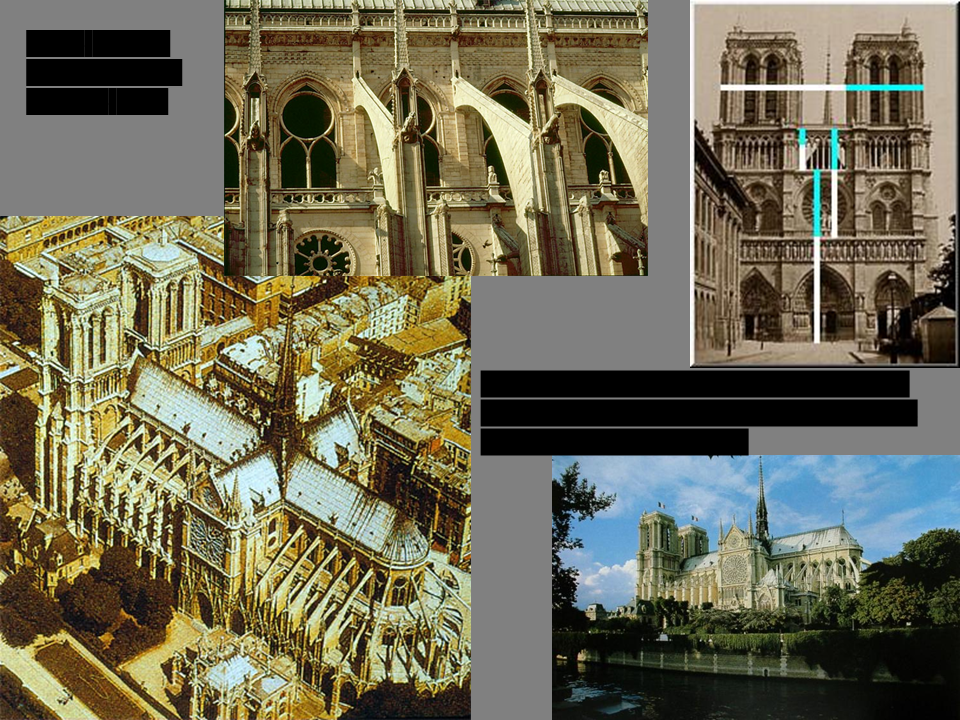
Notre-Dame
Describe the optical qualities of Gothic cathedrals and the structural innovations that make them possible.
Describe the optical qualities of Gothic cathedrals and the structural innovations that make them possible.
Paris, France, ca.1180-1200 GOTHIC
* flying buttresses—one of the first
* pointed and ribbed vaults
* phi—A rare, self-mirroring ratio in mathematical numbers; two quantities are in the golden ratio if their ratio is the same as the ratio of their sum to the larger of the two quantities.
* flying buttresses—one of the first
* pointed and ribbed vaults
* phi—A rare, self-mirroring ratio in mathematical numbers; two quantities are in the golden ratio if their ratio is the same as the ratio of their sum to the larger of the two quantities.
40
New cards

Chartres, ca. 1220 Rose Window
Gothic Period. North transept of Notre Dame, Paris, France, ca.1180-1200 GOTHIC
* The light had ties to holiness
* The light had ties to holiness
41
New cards
The two principal ingredients of glass
molten sand from silica & potash
42
New cards
how were sheets of glass made and how were colors added?
Sheets of Glass were made by using a blowing iron when glass was blown into balloon cylinders and splitting them open.
\
Colored by adding precious metals like cobalt, copper, and gold
\
Colored by adding precious metals like cobalt, copper, and gold
43
New cards
What happened during planning on a wood panel?
The sheet of glass cut from the cylinder is flattened with a piece of wood
44
New cards
How were pieces cut?
First cut using hot bar of iron in the medieval period
45
New cards
What sorts of things were painted on in enamel and then reheated to fuse the enamel?
silver stain often sued for highlighting features angel wings, crown, hair, and archetecture
46
New cards
What are cames and what do they do?
Strips of lead with grooves where esges of the glass can fit and hold it into place.
47
New cards

*Virgin of Jeanne d’Evreux*
discuss the materials 7 technique, function, style and how the object suits the power and authority of the patron
discuss the materials 7 technique, function, style and how the object suits the power and authority of the patron
from the abbey church, Saint Denis, France, 1339
* Queen of France— married Charles IV a few years before his death. Had three daughters and no sons
* A great patron of the arts
* The sculpture uses a lot of enamel
* scenes of Christ at the bottom (primarily teachings and the passion of Christ)
* How does Mary get to be Queen of heaven
* The position of the virgin is in a “Gothic s-curve”
* Queen of France— married Charles IV a few years before his death. Had three daughters and no sons
* A great patron of the arts
* The sculpture uses a lot of enamel
* scenes of Christ at the bottom (primarily teachings and the passion of Christ)
* How does Mary get to be Queen of heaven
* The position of the virgin is in a “Gothic s-curve”
48
New cards
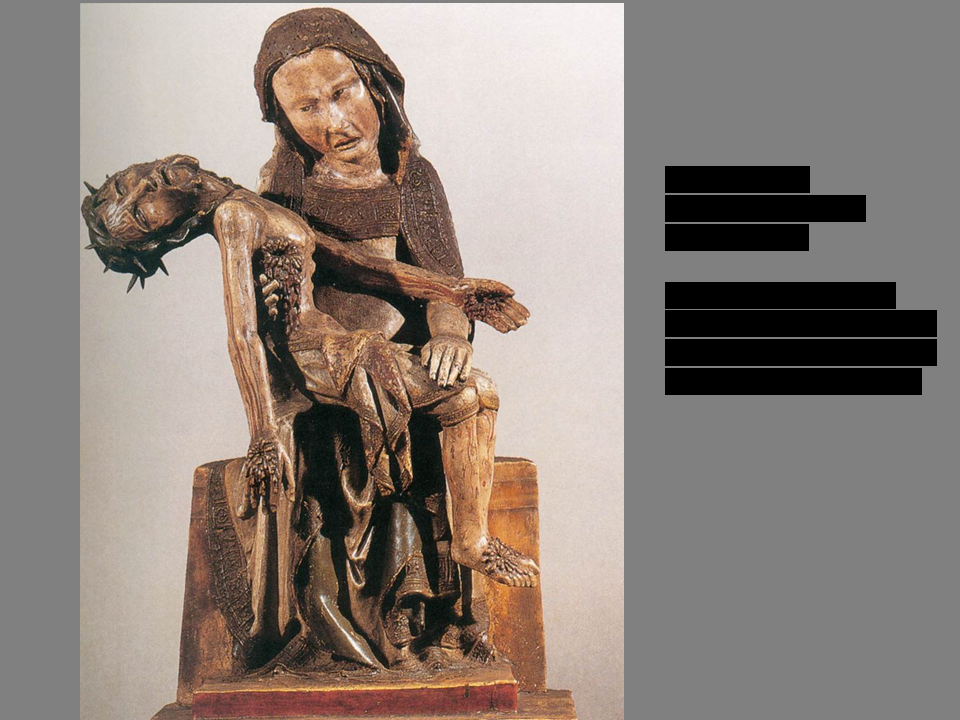
Röttgen Pietà
What is shown? With what values and for what communicative purposes was this object created?
What is shown? With what values and for what communicative purposes was this object created?
polychromed wood ca.1300-1325 LATE GOTHC
* Pieta — when the Virgin is holding the dead Christ in her arms
* Popular in Germanic lands at the time but not in Italy
* emphasis on suffering
* What survives is often made for rich people
* Prioritizing Jesus
* Heads are Larger to provide the easier ability to read expressions
* Pieta — when the Virgin is holding the dead Christ in her arms
* Popular in Germanic lands at the time but not in Italy
* emphasis on suffering
* What survives is often made for rich people
* Prioritizing Jesus
* Heads are Larger to provide the easier ability to read expressions
49
New cards
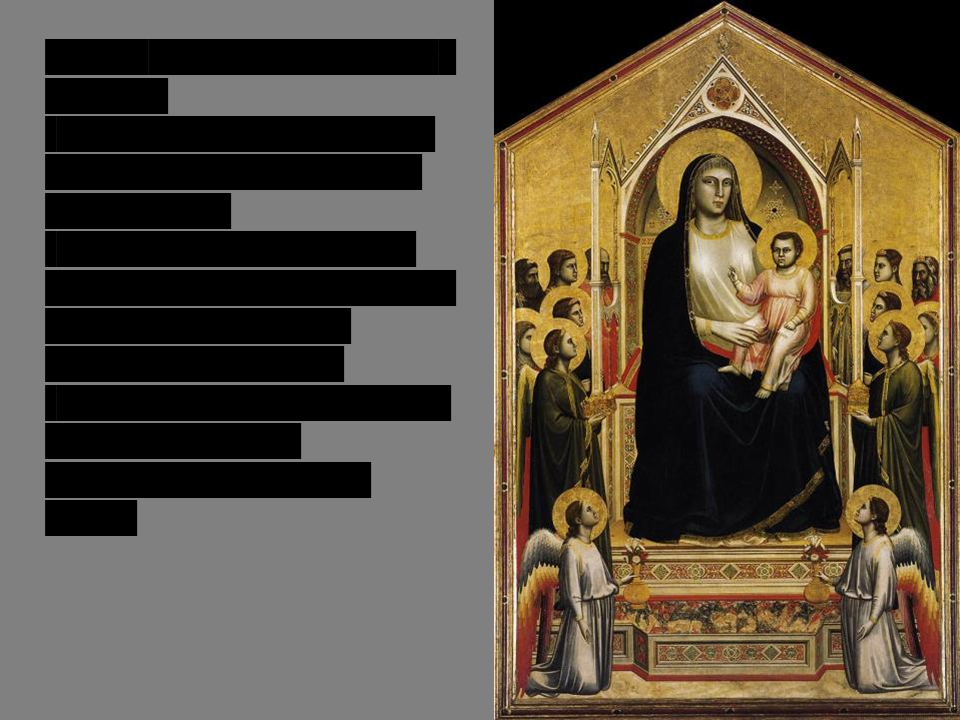
Giotto, Madonna Enthroned
Discuss by explaining how such a panel painting was made (steps)
Discuss by explaining how such a panel painting was made (steps)
ca. 1310 LATE GOTHIC
* Why does Giorgio Vasari see Giotto as surpassing his master Cimabue and creating a new style?
* \
* What values have changed compared to gold background Byzantine icons?
* Why does Giorgio Vasari see Giotto as surpassing his master Cimabue and creating a new style?
* \
* What values have changed compared to gold background Byzantine icons?
50
New cards
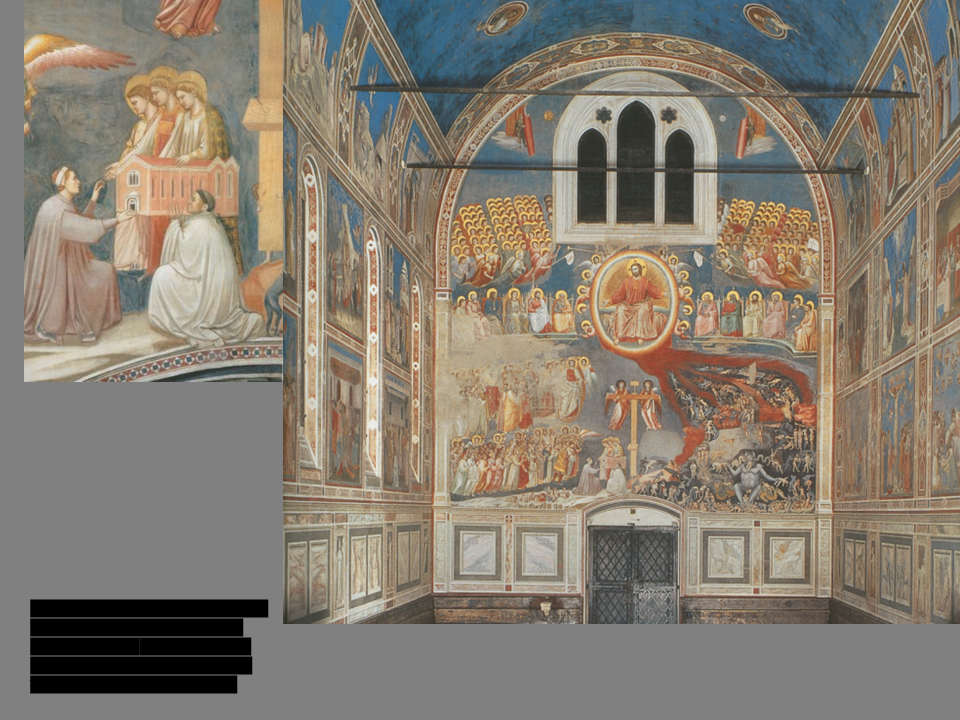
Giotto’s fresco cycle at the Arena Chapel, Padua, Italy,
Explain what is the purpose of this image and what it shows.
Explain what is the purpose of this image and what it shows.
LATE GOTHIC
ca. 1305 Last Judgment on the west wall Exoneration of the patron by inclusion in the frescos. Allows the audience rembers to reflect on their morality.
ca. 1305 Last Judgment on the west wall Exoneration of the patron by inclusion in the frescos. Allows the audience rembers to reflect on their morality.
51
New cards

Giotto’s fresco of the *Lamentation,* Arena Chapel
Padua, Italy, ca. 1305 LATE GOTHC
* What is this scene and what choices did the artist make in dramatically representing it?
* Lamentation with the use of depth
* With what materials/technique?
* Fresco
* How does it relate to the space in which it was painted?
* It’s in a church
* What is this scene and what choices did the artist make in dramatically representing it?
* Lamentation with the use of depth
* With what materials/technique?
* Fresco
* How does it relate to the space in which it was painted?
* It’s in a church
52
New cards
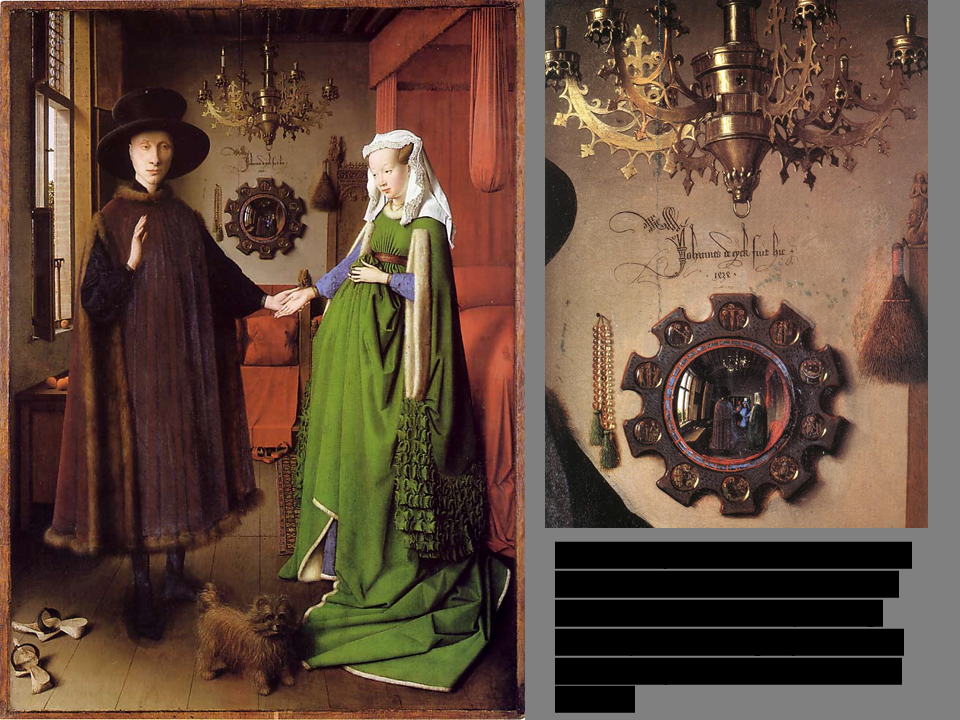
Jan van Eyck, *Giovanni Arnolfini and His Wife,*
Discuss in terms of oil-painting technique, meaning, symbolism, and other points from the text or lecture.
oil on wood, 1434 EARLY RENAISSANCE
* Wealthy couple
* Mirror using a fish-eye effect to showcase the artist's painting
* Trompe l’oeil— Fool the eye level of illusion -
* Wasn’t using a camera obscura technique as the chandelier perspective is incorrect
* Wealthy couple
* Mirror using a fish-eye effect to showcase the artist's painting
* Trompe l’oeil— Fool the eye level of illusion -
* Wasn’t using a camera obscura technique as the chandelier perspective is incorrect
53
New cards
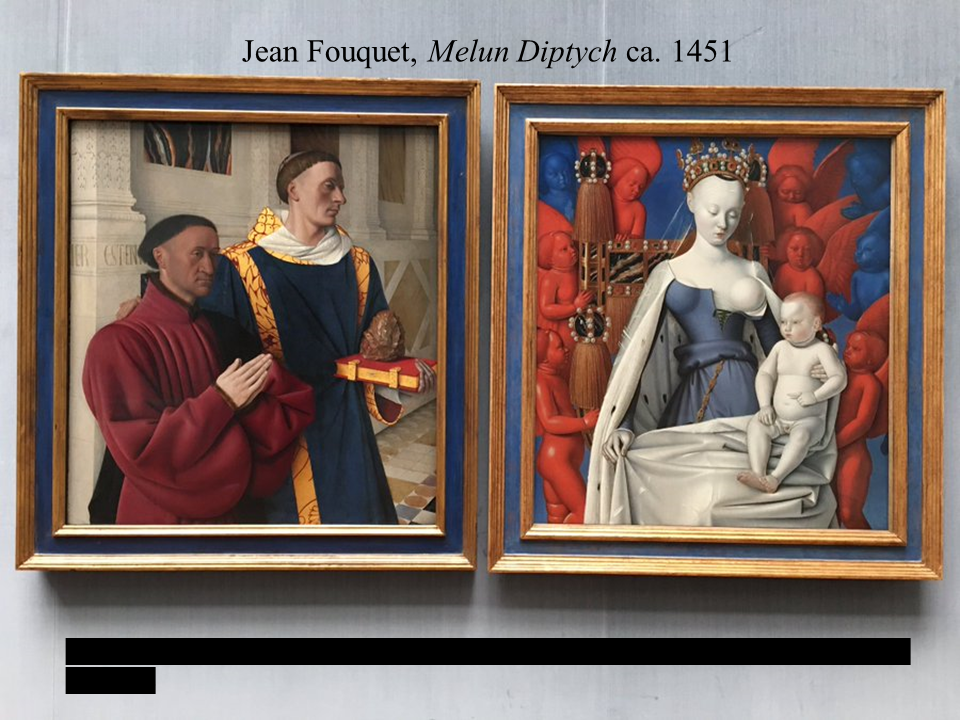
Jean Fouquet, *Melun Diptych*
Discuss materials & technique and how this work blends portraiture and sacred subjects
Discuss materials & technique and how this work blends portraiture and sacred subjects
ca. 1451, two panel oil painting EARLY RENAISSANCE
* Saint Stephen is often depicted with a rock
* King’s bursar - Stephen is praying
* Looks like they are praying to the Virgin Mary
* Beauty Standard is to look as pale as possible (also plucked forehead)
* Dedicated to French King Mistress Agnes after her death
* Saint Stephen is often depicted with a rock
* King’s bursar - Stephen is praying
* Looks like they are praying to the Virgin Mary
* Beauty Standard is to look as pale as possible (also plucked forehead)
* Dedicated to French King Mistress Agnes after her death
54
New cards
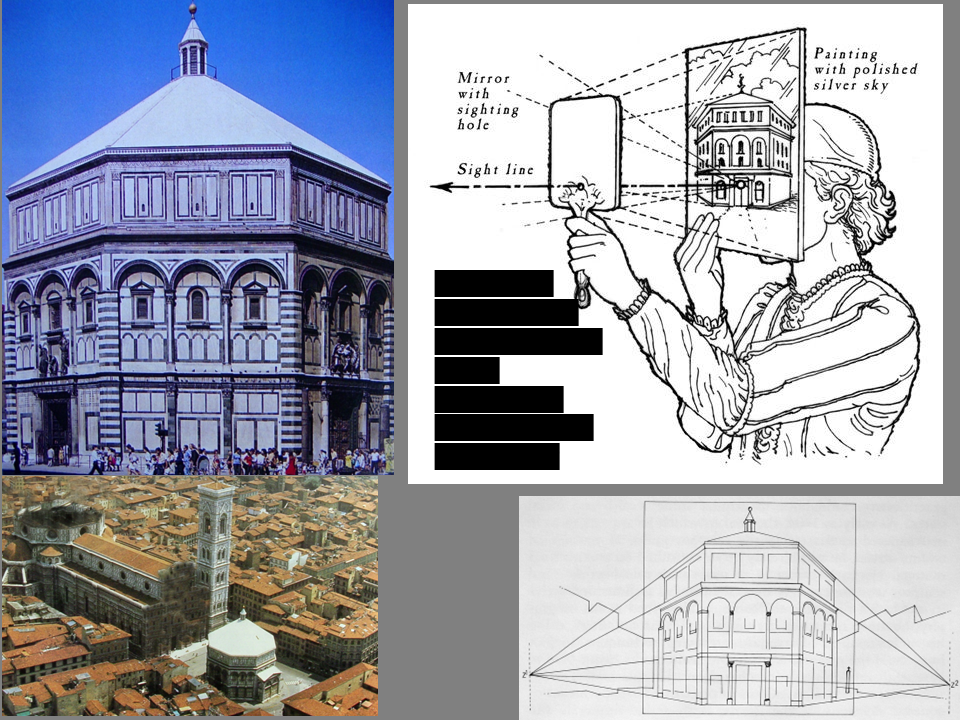
Relay who invented and by what means linear perspective (define); when and where?
Brunelleschi in Italy in the 1400s
55
New cards
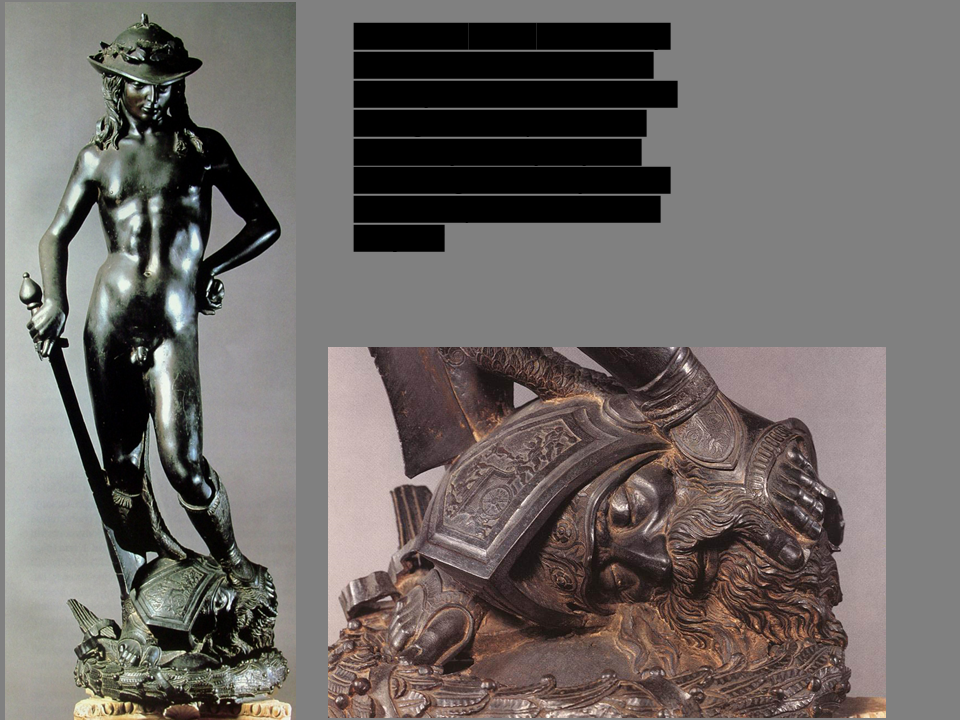
Donatello, *David*
1446 EARLY RENAISSANCE
* why was this bronze cast?
* What did it symbolize and what was its original inscription on its base?
* Stylistically why is it something noteworthy?
* What does it emphasize about the subject?
* why was this bronze cast?
* What did it symbolize and what was its original inscription on its base?
* Stylistically why is it something noteworthy?
* What does it emphasize about the subject?
56
New cards
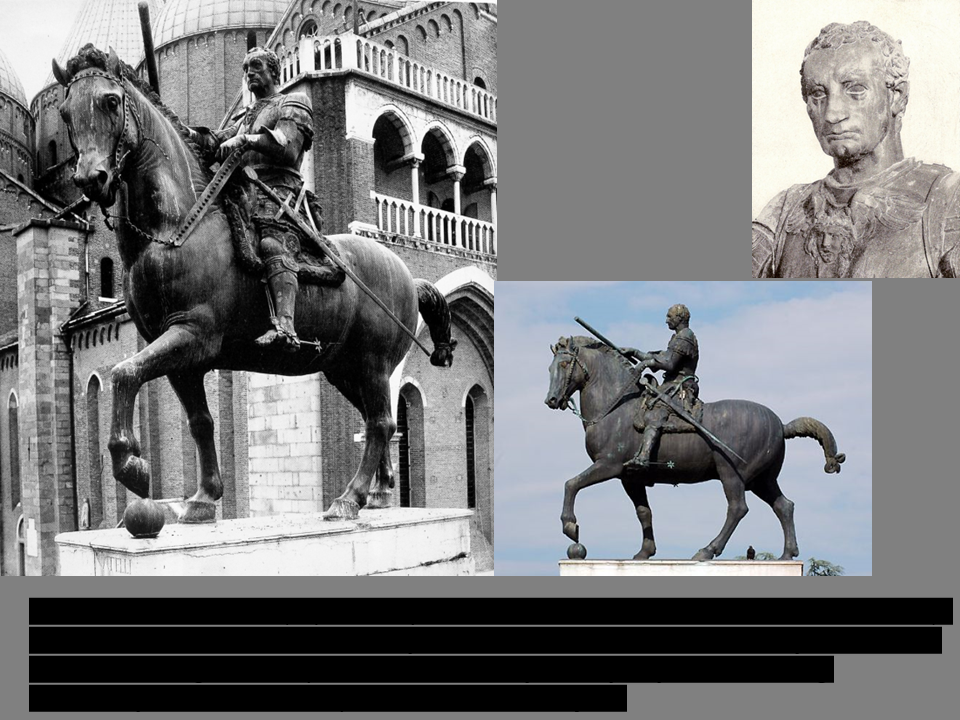
Donatello, *Gattamelata*
ca. 1445-53, hollow-cast bronze EARLY RENAISSANCE
* Equestrian portrait of Venetian commander Erasmo da Narni)
* First full-sized equestrian statue of the Italian Renaissance
* Equestrian portrait of Venetian commander Erasmo da Narni)
* First full-sized equestrian statue of the Italian Renaissance
57
New cards
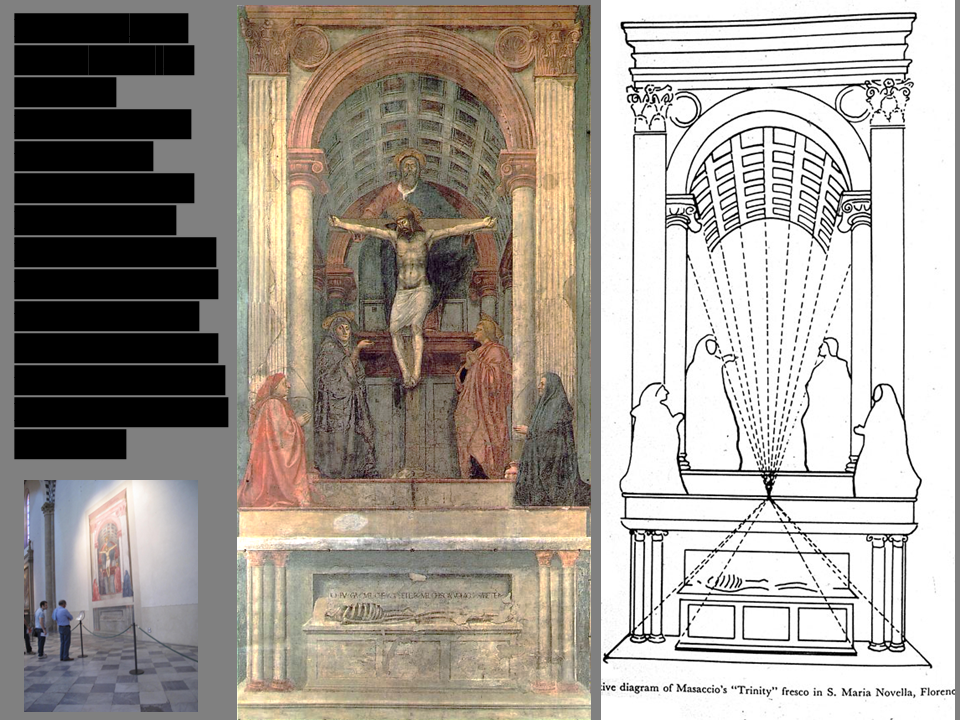
Masaccio, *Holy Trinity*, 1425-28 (Berto di Bartolomeo and wife Sandra)
Describe what is shown and what this reveals about Renaissance thoughts of ancient Rome, Christianity, and death.
Describe what is shown and what this reveals about Renaissance thoughts of ancient Rome, Christianity, and death.
Church of Santa Maria Novella, Florence EARLY RENAISSANCE
* Users linear perspective, memento mori, portions are included on the side, previously hidden
* EARLY RENAISSANCE TRUE FRESCO
* Users linear perspective, memento mori, portions are included on the side, previously hidden
* EARLY RENAISSANCE TRUE FRESCO
58
New cards
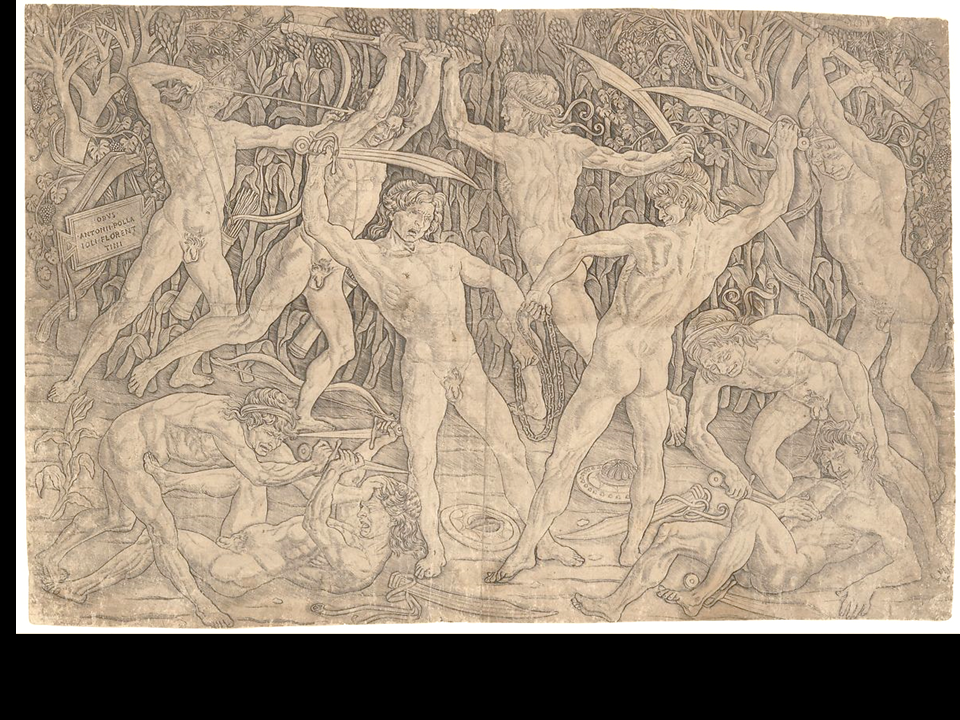
Antonio Pollaiuolo, *Battle of Ten Nudes*
Discuss in terms of materials, techniques, paganism, artistic priorities, etc.
Discuss in terms of materials, techniques, paganism, artistic priorities, etc.
engraving, ca. 1465 EARLY RENAISSANCE
* Fantasizing a battle scene from the past and showing the body at nearly every angle to show that he’s mastered the human body
* Leonardo was not the only person to study the bodies
* Uses engraving
* Ties to paganism
* Fantasizing a battle scene from the past and showing the body at nearly every angle to show that he’s mastered the human body
* Leonardo was not the only person to study the bodies
* Uses engraving
* Ties to paganism
59
New cards
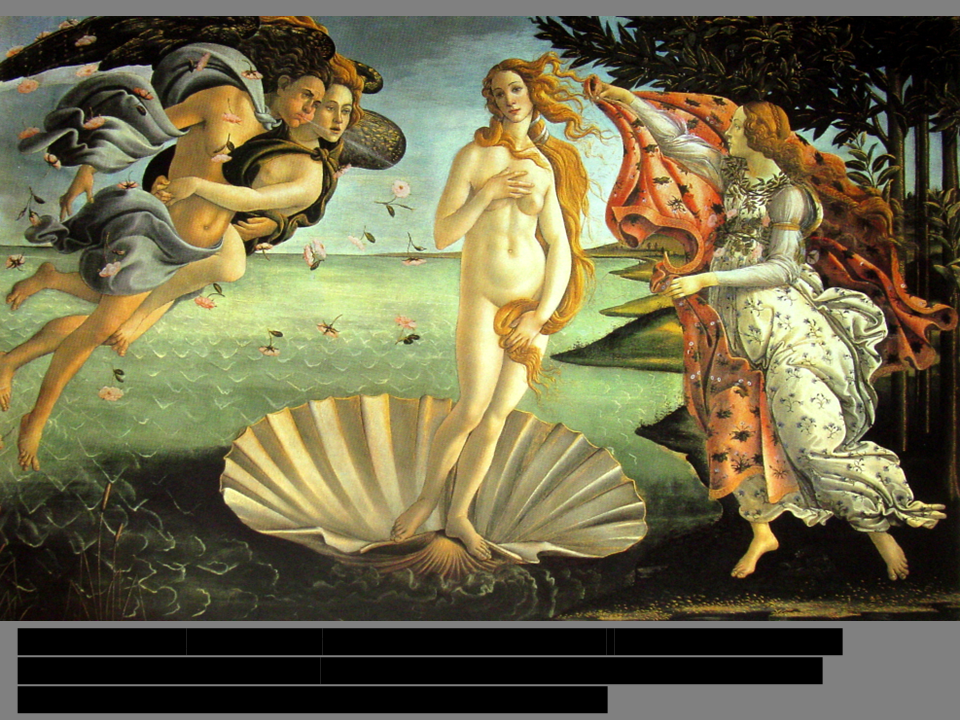
Sandro Botticelli, *Birth of Venus*
Although we do not know much about this painting, discuss in terms of what we see, ancient sculpture, nudity, meanings, and why it might have been commissioned.
Although we do not know much about this painting, discuss in terms of what we see, ancient sculpture, nudity, meanings, and why it might have been commissioned.
tempera on canvas, ca. 1484-86 HIGH RENAISSANCE
* Commissioned by the Medici family (Florentine Bankers)as a wedding gift
* Based on Aphrodite Myth
* Representations of Venus were popular as wedding gifts
* Aphrodite Roman sculpture was well-known at the time and painting shows that he was as good as the sculpture
* Commissioned by the Medici family (Florentine Bankers)as a wedding gift
* Based on Aphrodite Myth
* Representations of Venus were popular as wedding gifts
* Aphrodite Roman sculpture was well-known at the time and painting shows that he was as good as the sculpture
60
New cards
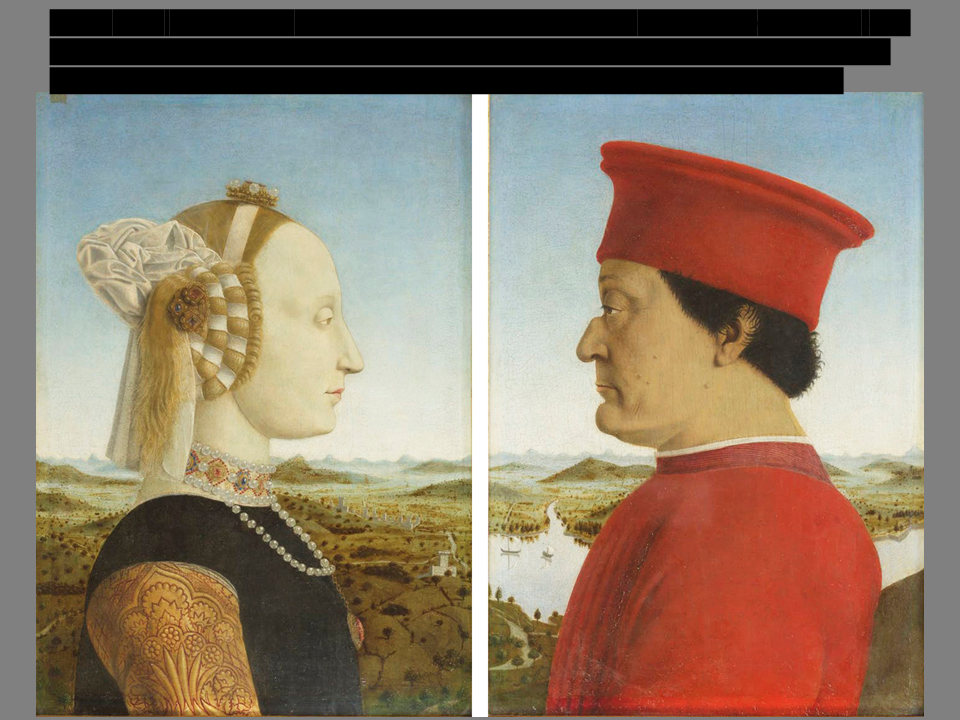
Piero della Francesca, *Battista Sforza and Federico da Montefeltro*,
ca. 1472-74; EARLY RENAISSANCE
* what does this reveal about Italian Renaissance portraiture conventions?
* only the elite can have portraits— that showed status and beauty due to the profile
* Convention of beauty but also spoke to antiquity and power (along with pedigree). Elites liked to collect portraits of the Caesars which showed them in profile— wanted to be like them.
* What interesting things did you learn about the lives of this Renaissance couple?
* the couple was an arranged marriage
* **Battista Sforza** (Princess from Milan)— has a plucked hairline and a necklace of pearls (a common wedding gift as it signified purity)
* Husband— **Federico da Montefeltro**— Wears crimson which was very expensive at the time
* what does this reveal about Italian Renaissance portraiture conventions?
* only the elite can have portraits— that showed status and beauty due to the profile
* Convention of beauty but also spoke to antiquity and power (along with pedigree). Elites liked to collect portraits of the Caesars which showed them in profile— wanted to be like them.
* What interesting things did you learn about the lives of this Renaissance couple?
* the couple was an arranged marriage
* **Battista Sforza** (Princess from Milan)— has a plucked hairline and a necklace of pearls (a common wedding gift as it signified purity)
* Husband— **Federico da Montefeltro**— Wears crimson which was very expensive at the time
61
New cards
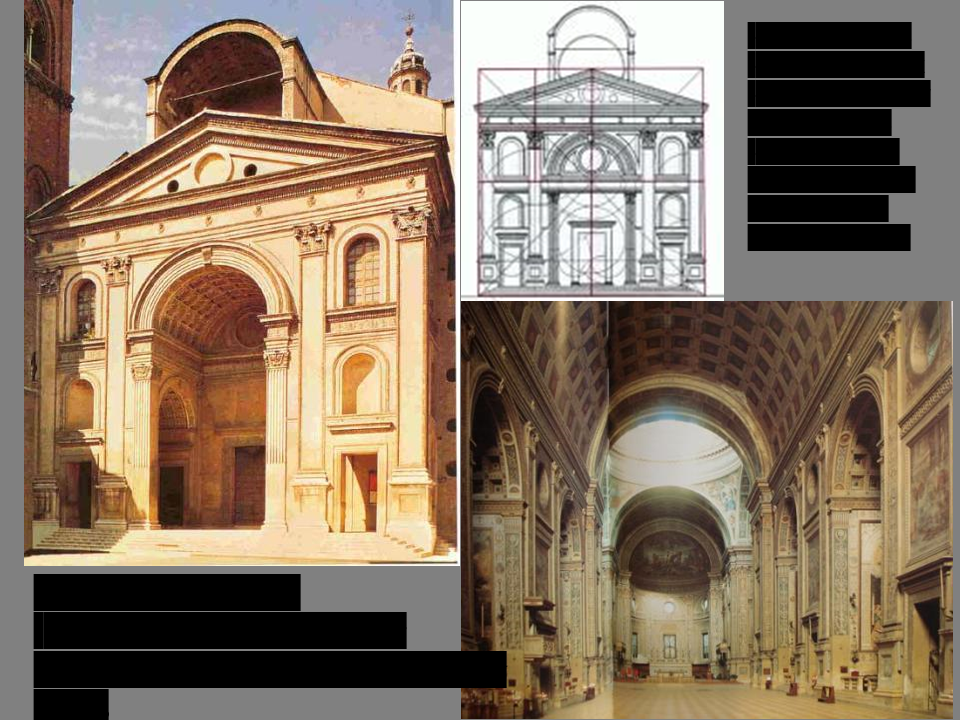
Church of San Andrea, Mantua
Architect: Leon Battista Alberti, Italy 1470s EARLY RENAISSANCE
* Roman arches
* Vitruvian syntax
* geometric clarity & proportions
* barrel vaults, ancient Roman-style coffers, pediments, etc.
* Roman arches
* Vitruvian syntax
* geometric clarity & proportions
* barrel vaults, ancient Roman-style coffers, pediments, etc.
62
New cards
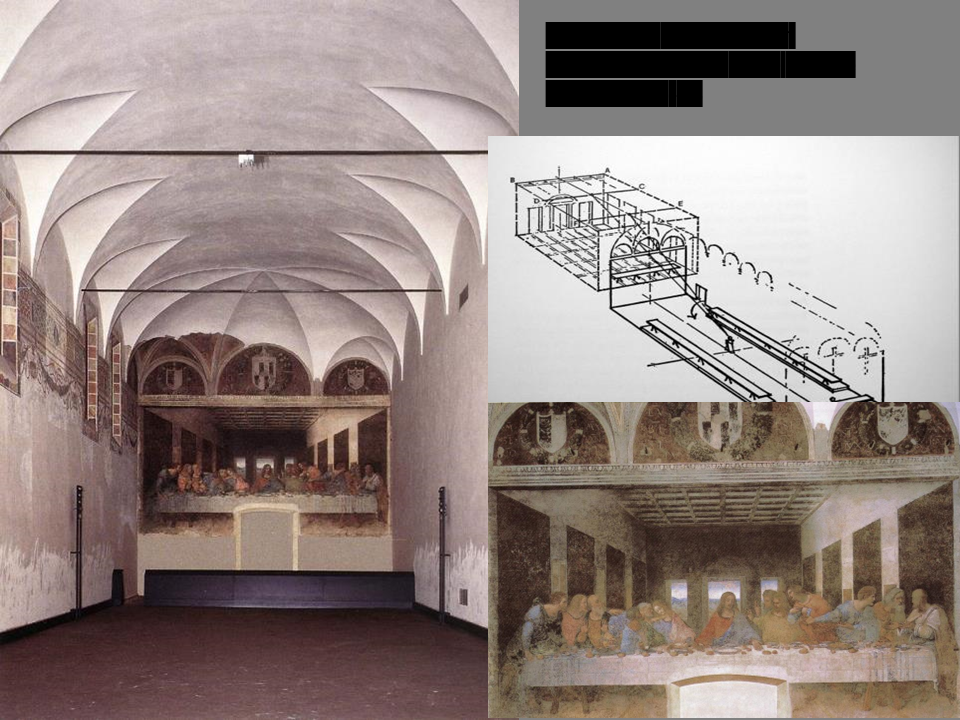
Leonardo, *Last Supper*
refectory of S.M. delle Grazie Milan, 1495-98 HIGH RENAISSANCE
* The coat of arms belonged to the patron, the Duke of Milan
* Refectory (dining hall) of a church in Milan
* Actually a mural
* Orthogonal lines converge on Christ
* Not a true fresco as shown by distressing
* The coat of arms belonged to the patron, the Duke of Milan
* Refectory (dining hall) of a church in Milan
* Actually a mural
* Orthogonal lines converge on Christ
* Not a true fresco as shown by distressing
63
New cards
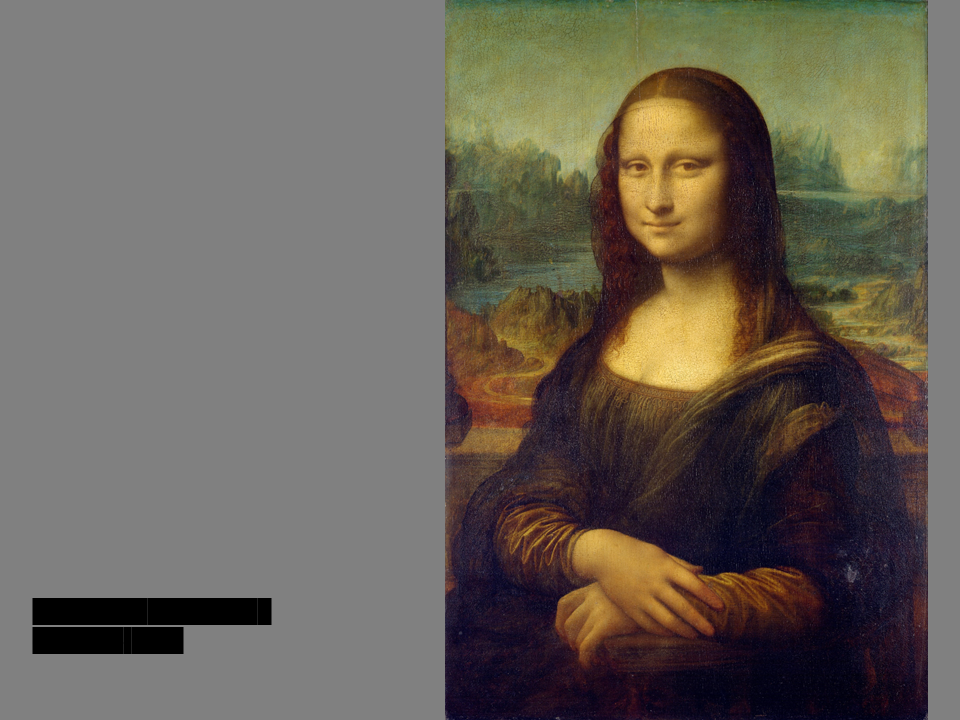
Leonardo, *Mona Lisa*
ca. 1503-1505 HIGH RENAISSANCE
* a good example of sfumato "smoky effect"
* Never given to the sitter
* Interested in forces of erosion
* the background is not even but mostly natural except for a potential road
* The sitter is (Potentially) Lisa del Giocondo
* a good example of sfumato "smoky effect"
* Never given to the sitter
* Interested in forces of erosion
* the background is not even but mostly natural except for a potential road
* The sitter is (Potentially) Lisa del Giocondo
64
New cards
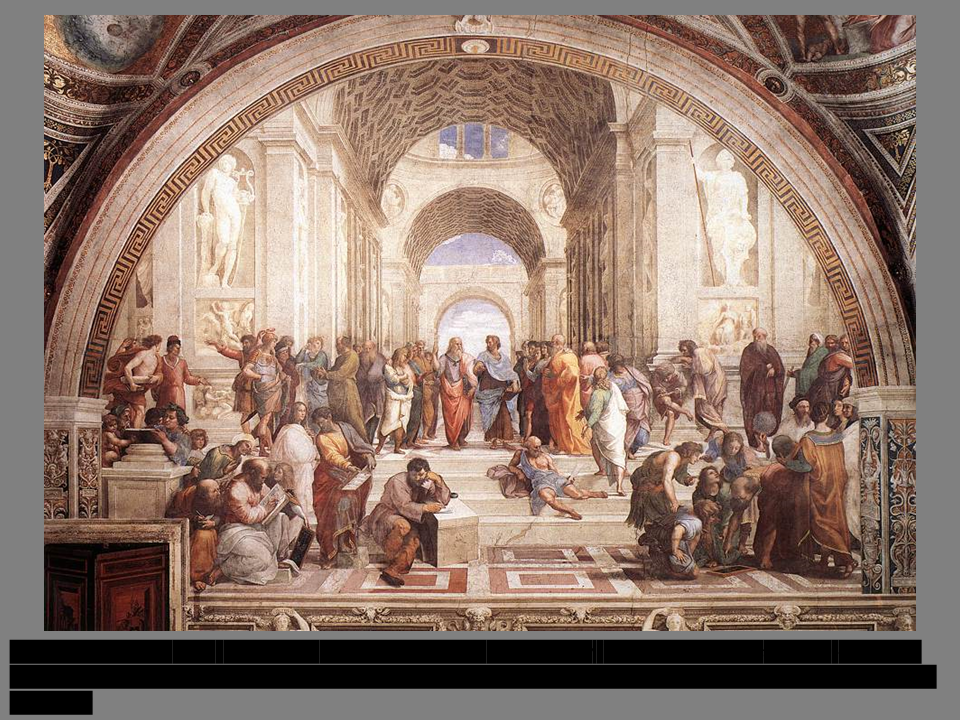
Raphael, Stanza della Segnatura, Vatican Palace: *Philosophy* (*School of Athens*)
1509-11, High Renaissance.
* Based on its location and the veiled portraits, how might this fresco declare a “New Athens”?
* Aristotle and Socrates are in the center — the former is the forefather of science
* Socrates is focused on metaphorical and heavenly forms
* Aristotle focuses on more realistic applications of philosophy
* Latter came out of stoic condition
* Coffer ceiling
* **Pensieroso-** “The Thinker” pose associated with philosophers and light melancholy
* Zoroaster (astronomy)
* Aristotle
* Ptolemy(geography)
* Heraclitus
* Socrates
* Based on its location and the veiled portraits, how might this fresco declare a “New Athens”?
* Aristotle and Socrates are in the center — the former is the forefather of science
* Socrates is focused on metaphorical and heavenly forms
* Aristotle focuses on more realistic applications of philosophy
* Latter came out of stoic condition
* Coffer ceiling
* **Pensieroso-** “The Thinker” pose associated with philosophers and light melancholy
* Zoroaster (astronomy)
* Aristotle
* Ptolemy(geography)
* Heraclitus
* Socrates
65
New cards
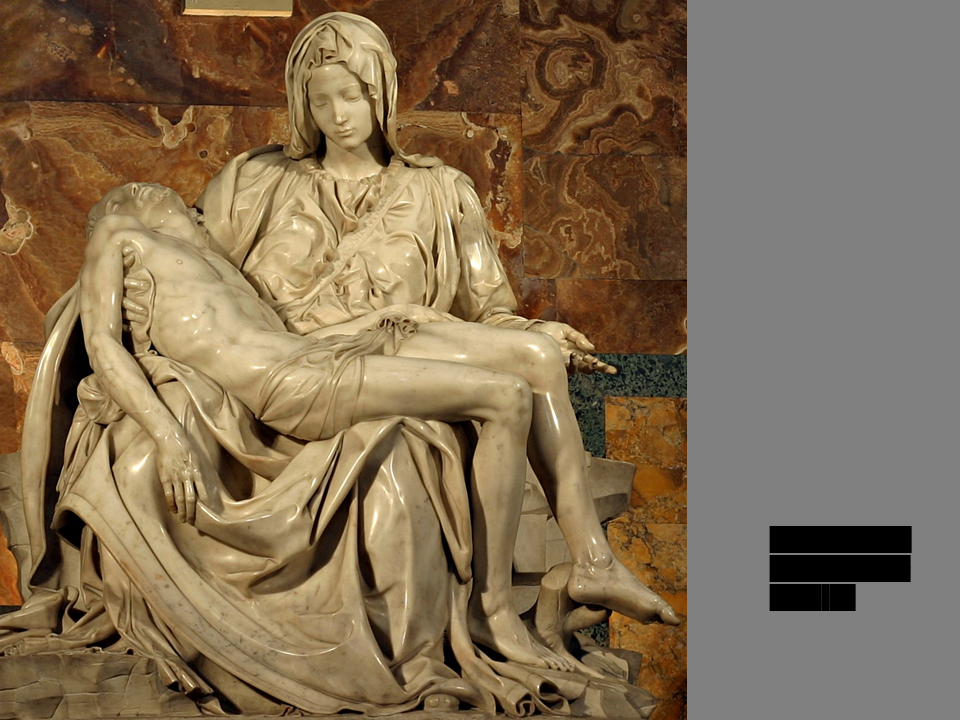
Michelangelo *Vatican Pieta*
1498-99
* White marble
* Most polished work of Mikey
* Pieta— Mary holding her dead son christ
* Mary looks so young because her beauty is timeless
* Studied cadavers as well
* White marble
* Most polished work of Mikey
* Pieta— Mary holding her dead son christ
* Mary looks so young because her beauty is timeless
* Studied cadavers as well
66
New cards

Michelangelo, *David*, 1501-04
* How does it capture a Biblical moment?
* Slingshot in hand
* Comes from a previously damaged block of stone
* How is it a “rebirth” of antiquity?
* Sculpted in a style similar to the Romans
* When moved to the communal palace, does it become a symbol of Florence? Symbolizing what?
* Symbolizing resilience against enemies forces
* Slingshot in hand
* Comes from a previously damaged block of stone
* How is it a “rebirth” of antiquity?
* Sculpted in a style similar to the Romans
* When moved to the communal palace, does it become a symbol of Florence? Symbolizing what?
* Symbolizing resilience against enemies forces
67
New cards
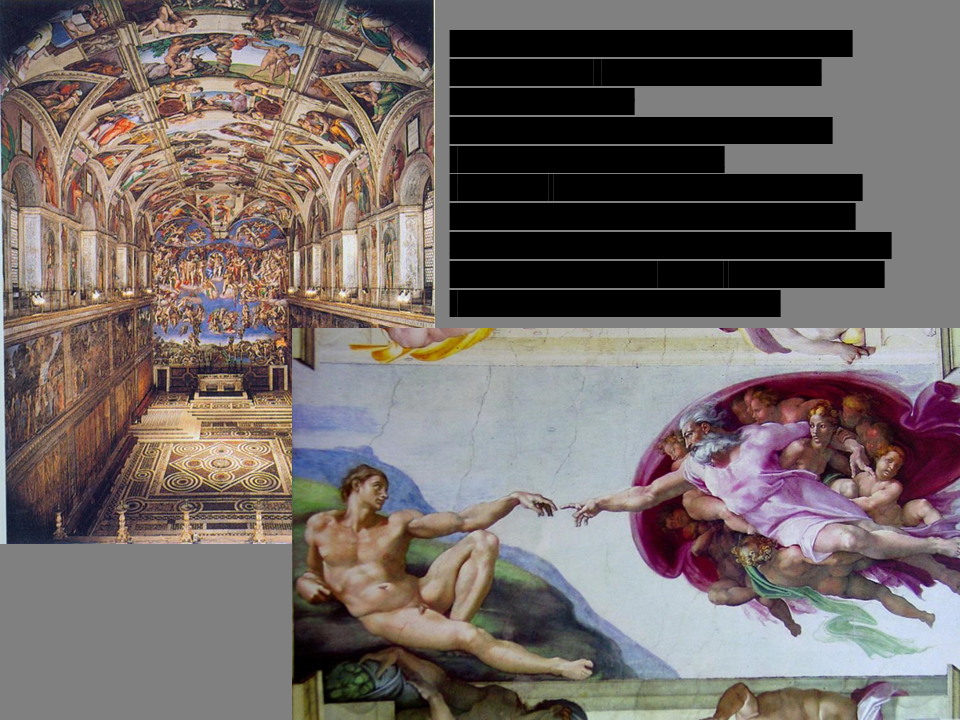
Michelangelo, Sistine Chapel Ceiling, Vatican, 1508-1512 (Pope Julius II)
*Creation of Adam*
*Creation of Adam*
* -facts of the daunting task
* 5428ft of fresco surface
* 66ft. up
* Replaces a simple blue field with golden stars
* The design includes 343 figures
* 9 scenes from genesis
* He had to paint it standing up
* -principle parts (Creation to Flood, Old Testament Prophets & Sybils, Christ’s Ancestors/Old Testament) and framing of the Christian story (ignudi & architecture)
* Design evolved based in the scaffolding
* -your observations on M’s style
* colored modeling— changing hues to achieve lightness and darkness
* 5428ft of fresco surface
* 66ft. up
* Replaces a simple blue field with golden stars
* The design includes 343 figures
* 9 scenes from genesis
* He had to paint it standing up
* -principle parts (Creation to Flood, Old Testament Prophets & Sybils, Christ’s Ancestors/Old Testament) and framing of the Christian story (ignudi & architecture)
* Design evolved based in the scaffolding
* -your observations on M’s style
* colored modeling— changing hues to achieve lightness and darkness
68
New cards
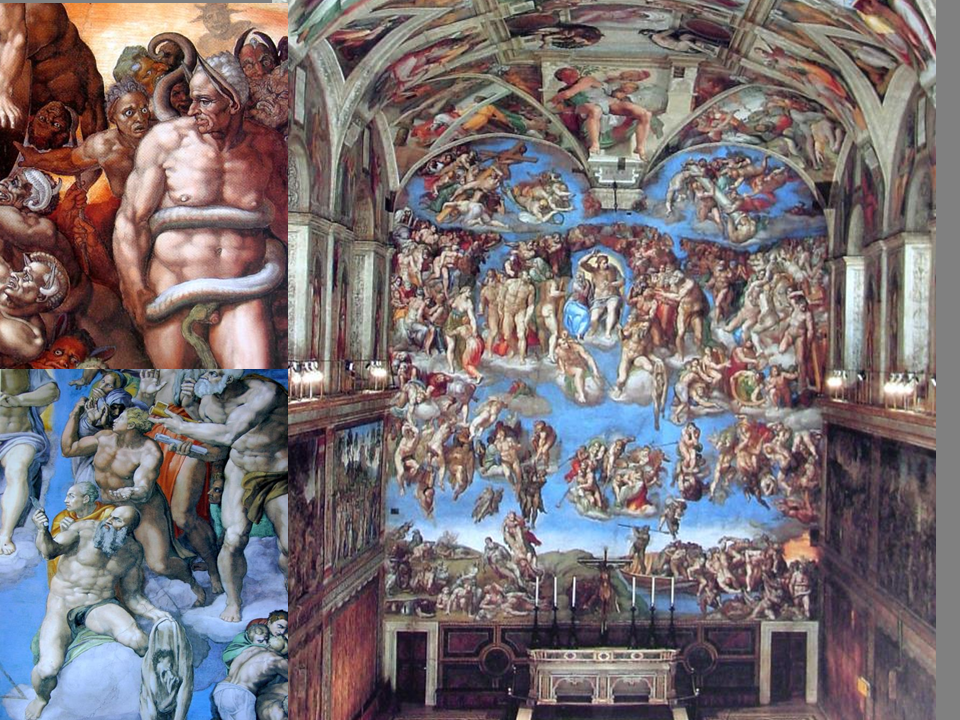
Michelangelo, Last Judgment, Sistine Chapel, Vatican,
* 1534-1541 MANNERISM
* The idea that you want to be raised up to heaven over going to hell
* People in the clouds are saints including Saint Catherine
* Instances of Artisic revenge- Minos (man with a snake wrapped around him biting his own genitals. Based on the Pope’s treasurer (disputes over where figures should be nude or not and disputes about money)
* Pope allowed it to be kept (he has no business over Hell)
* loincloths painted by someone else
* The idea that you want to be raised up to heaven over going to hell
* People in the clouds are saints including Saint Catherine
* Instances of Artisic revenge- Minos (man with a snake wrapped around him biting his own genitals. Based on the Pope’s treasurer (disputes over where figures should be nude or not and disputes about money)
* Pope allowed it to be kept (he has no business over Hell)
* loincloths painted by someone else
69
New cards
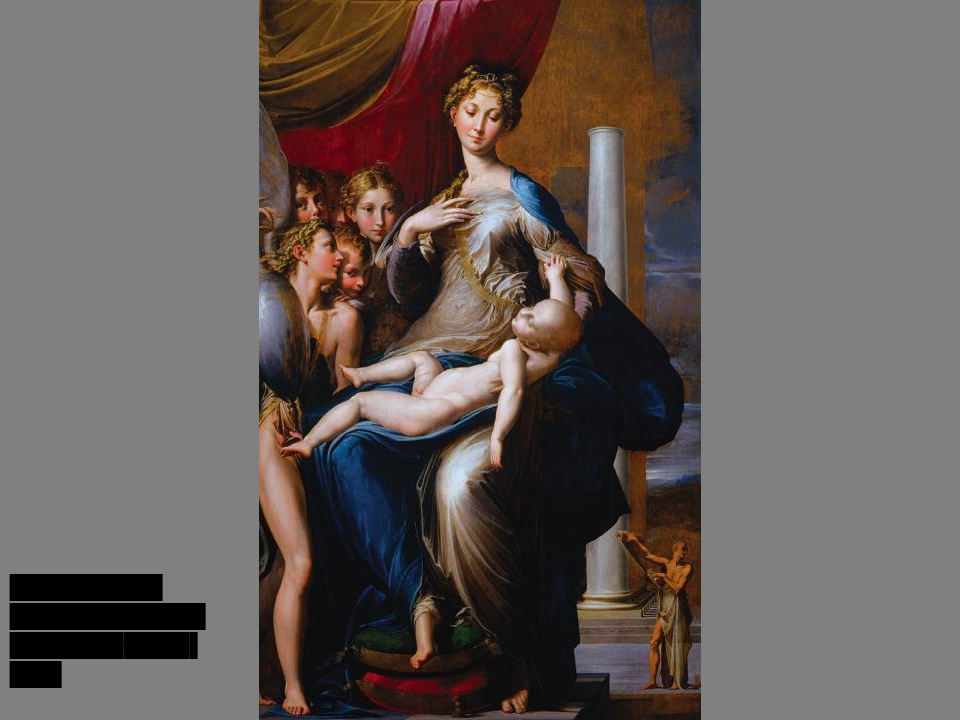
Parmigianino, *Madonna with the Long Neck*
1534-1540 MANNERISM
* Virgin Mary with Jesus
* Madonna is twice the size of angels
* Virgin Mary with Jesus
* Madonna is twice the size of angels
70
New cards
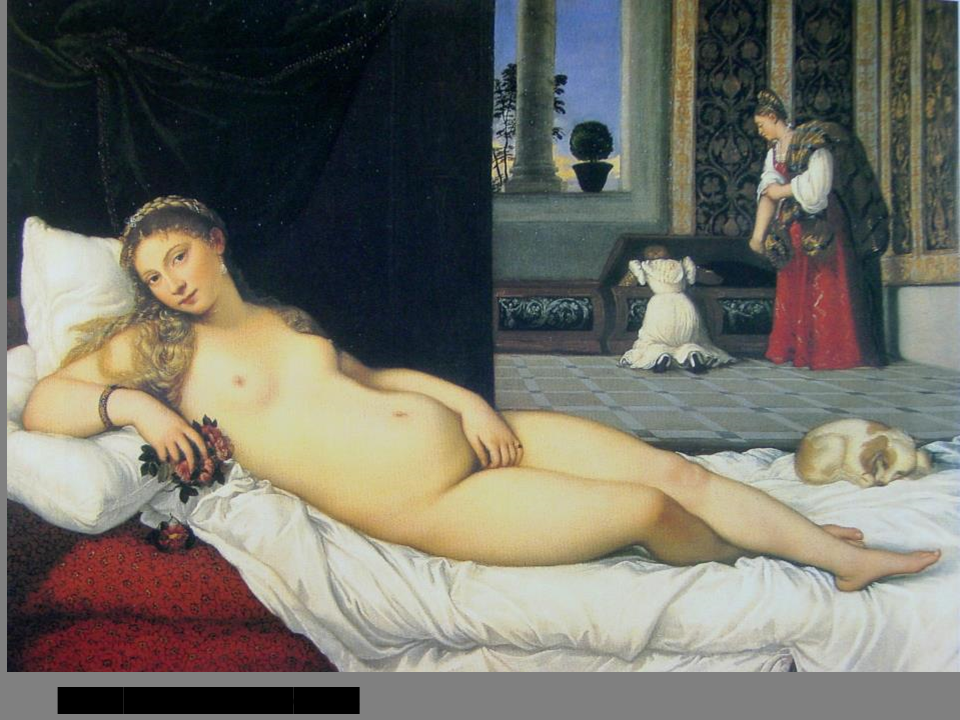
Titan, *Venus of Urbino*,
1538
* Part of the Venetian Renaissance
* Potentially someone posing nude in the disguise of Venus
* Part of the Venetian Renaissance
* Potentially someone posing nude in the disguise of Venus
71
New cards
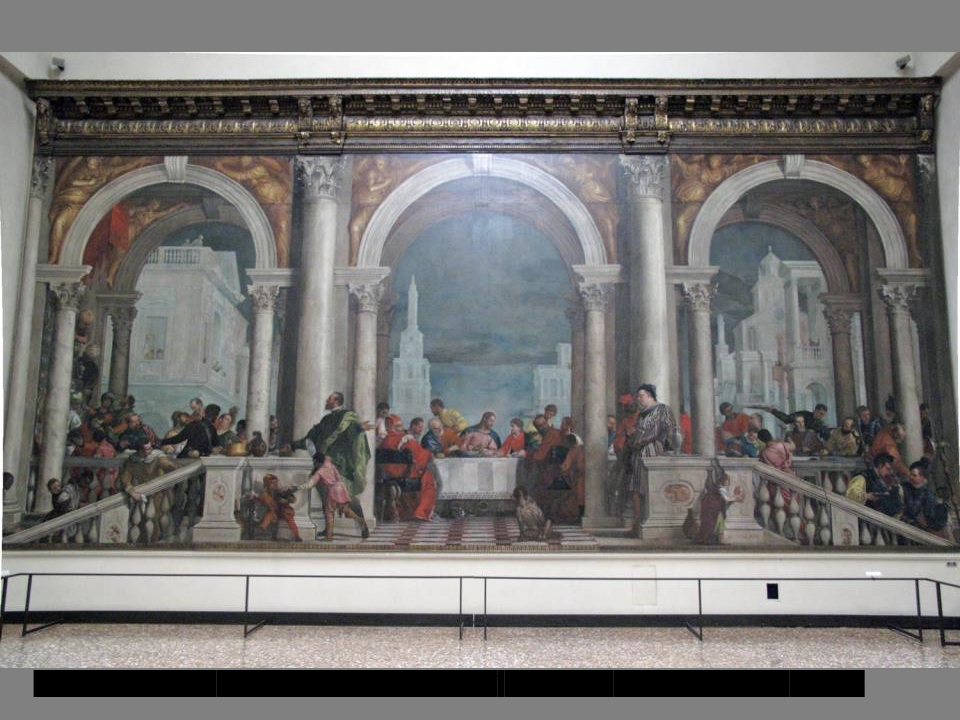
Paolo Veronese, *Christ in the House of Levi* (originally *The Last Supper*),
1573
* Lot of stuff that looks more like 1500s Venice than Bibical Era.
* Not perfect but realistic— someone has a nosebleed, there’s a little person holding a chicken, there’s a dog
* Veronse’s response to accusations of heresy
* Lot of stuff that looks more like 1500s Venice than Bibical Era.
* Not perfect but realistic— someone has a nosebleed, there’s a little person holding a chicken, there’s a dog
* Veronse’s response to accusations of heresy
72
New cards
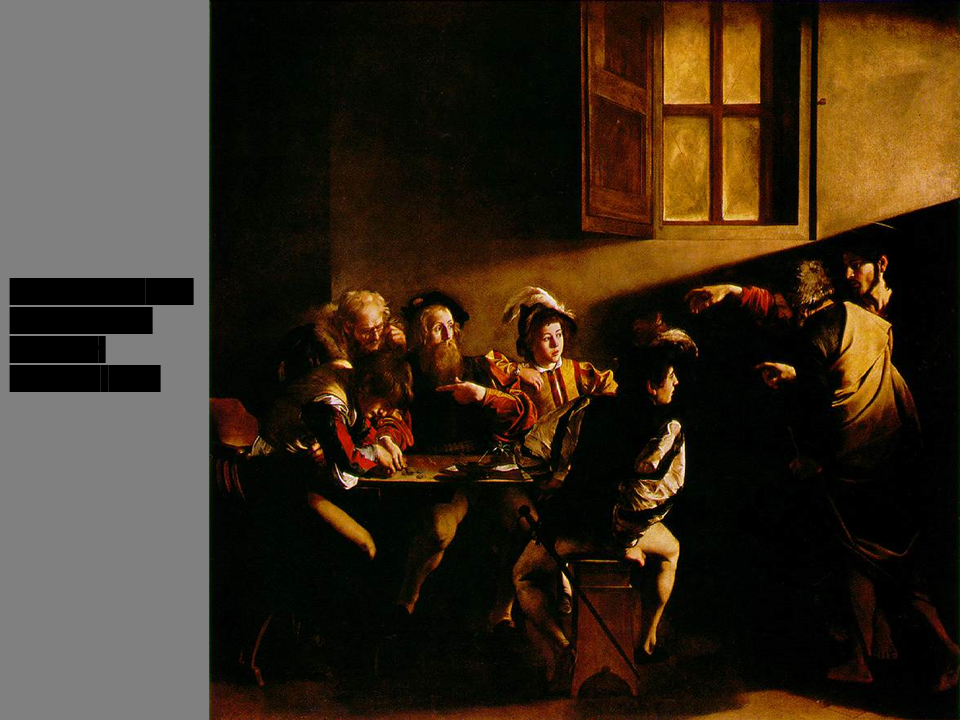
Caravaggio, *The Calling of St. Matthew*,
ca. 1597-1601 EARLY BAROQUE
* Started showing Jesus in shadow
* tenerism— shadowy style with a hidden light source off to the side
* Started showing Jesus in shadow
* tenerism— shadowy style with a hidden light source off to the side
73
New cards
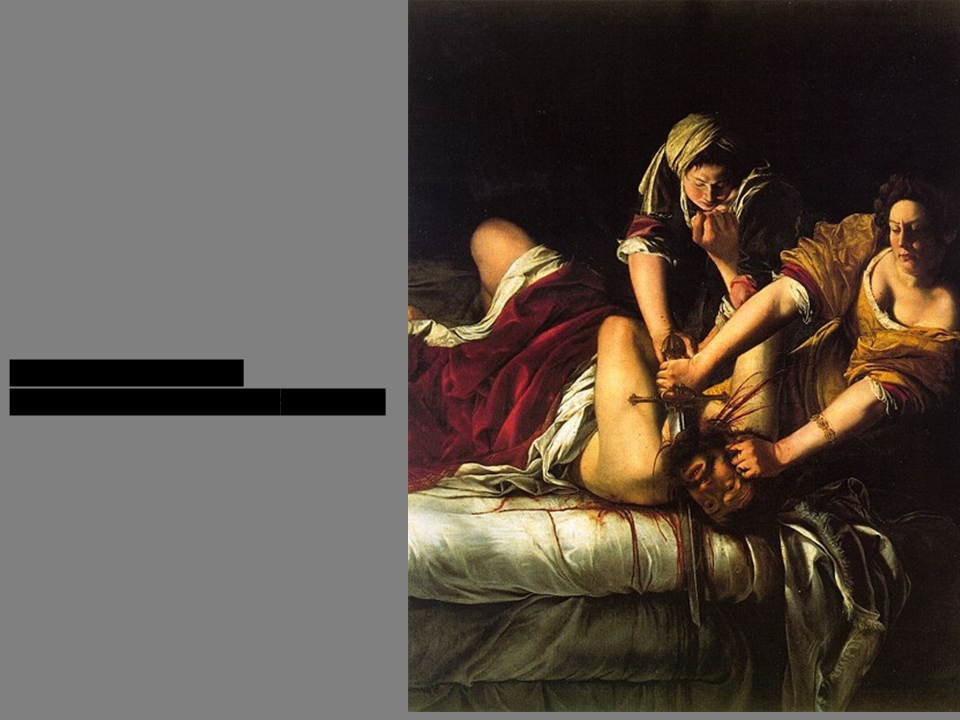
Artemisia Gentileschi, *Judith Slaying Holofernes*,
ca. 1620 EARLY BAROQUE
* Female artist
* employs chiaroscuro
* Biblical Story-- violent depiction
* Female artist
* employs chiaroscuro
* Biblical Story-- violent depiction
74
New cards
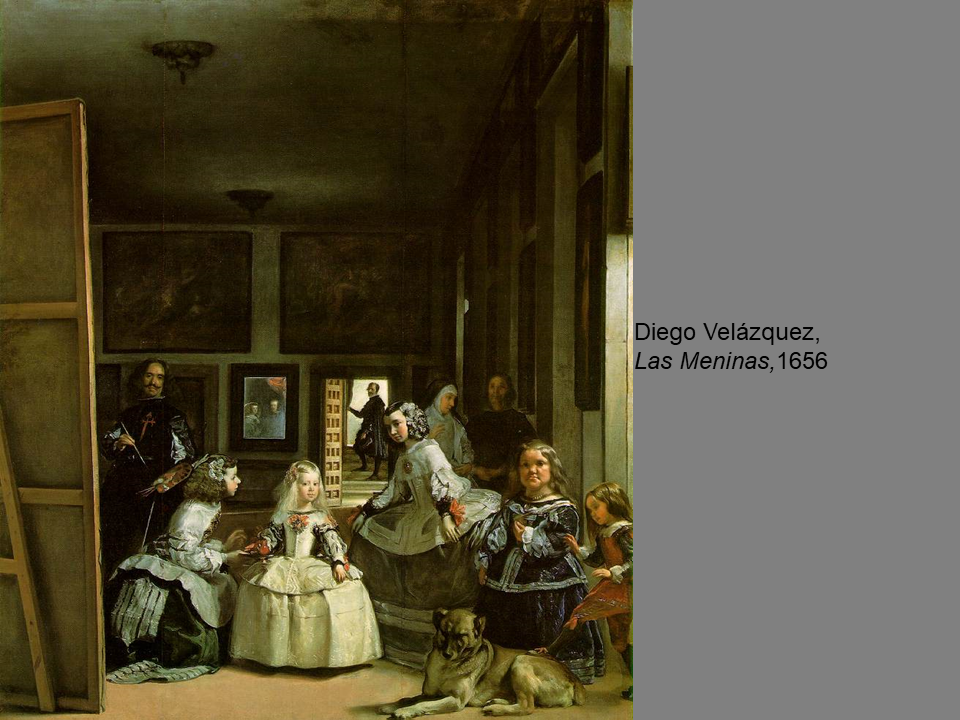
Diego Velázquez, *Las Meninas,*
1656 SPANISH Baroque “The Handmaidens”
* Example of the Spanish Baroque movement
* Sprezzatura- the ability to dash up something that from further back, appears as realistic
* Received knighthood three years after painting (the reason behind the red symbol on his jacket. May have been added after he received his knighthood
* Flattened mirror in the background with a beveled edge
* Example of the Spanish Baroque movement
* Sprezzatura- the ability to dash up something that from further back, appears as realistic
* Received knighthood three years after painting (the reason behind the red symbol on his jacket. May have been added after he received his knighthood
* Flattened mirror in the background with a beveled edge
75
New cards
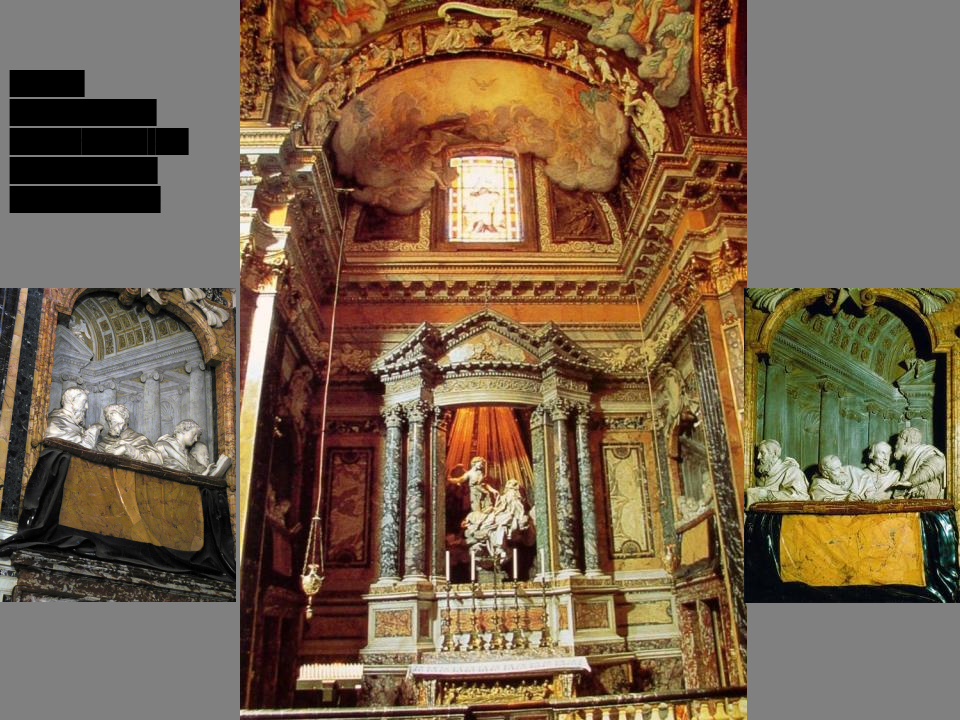
Bernini, *Ecstasy of St. Teresa*
1645-52, S. Maria della Vittoria, Rome BAROQUE
* also made Gianlorenzo Bernini, David, 1623
* Showcases the drama in Italian baroque
* also made Gianlorenzo Bernini, David, 1623
* Showcases the drama in Italian baroque
76
New cards
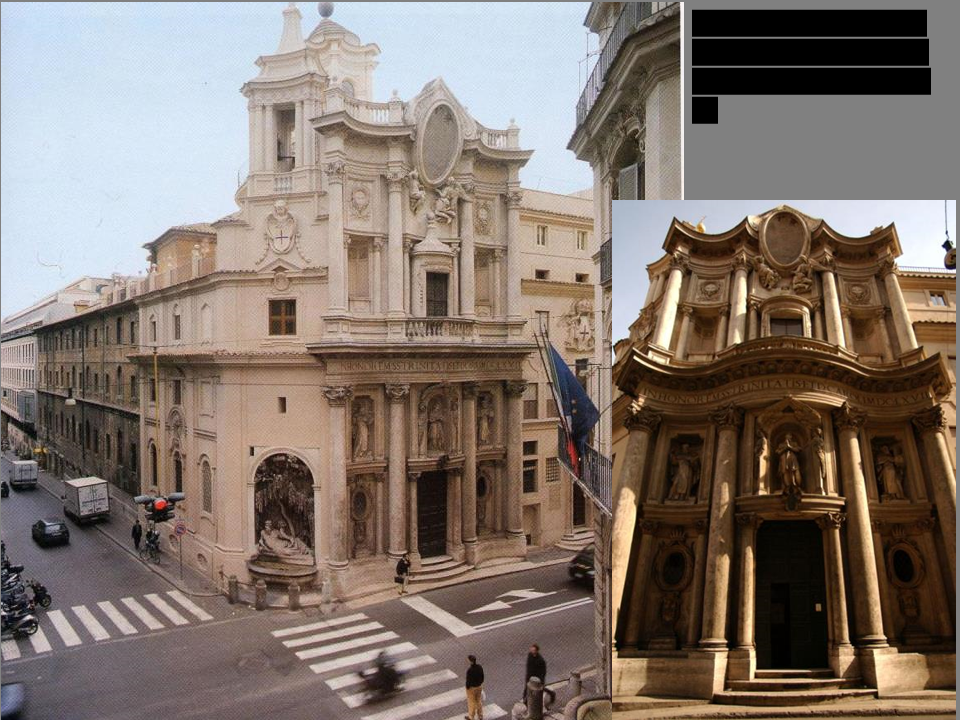
Francesco Borromini, *San Carlo alle Quatre Fontane*, Rome,
1638-41 BAROQUE
* Plainer
* Linear with straight lines
* Inspired by Ancient Rome
* The ceiling dome uses foreshortening and an oval shape to appear taller
* Plainer
* Linear with straight lines
* Inspired by Ancient Rome
* The ceiling dome uses foreshortening and an oval shape to appear taller
77
New cards
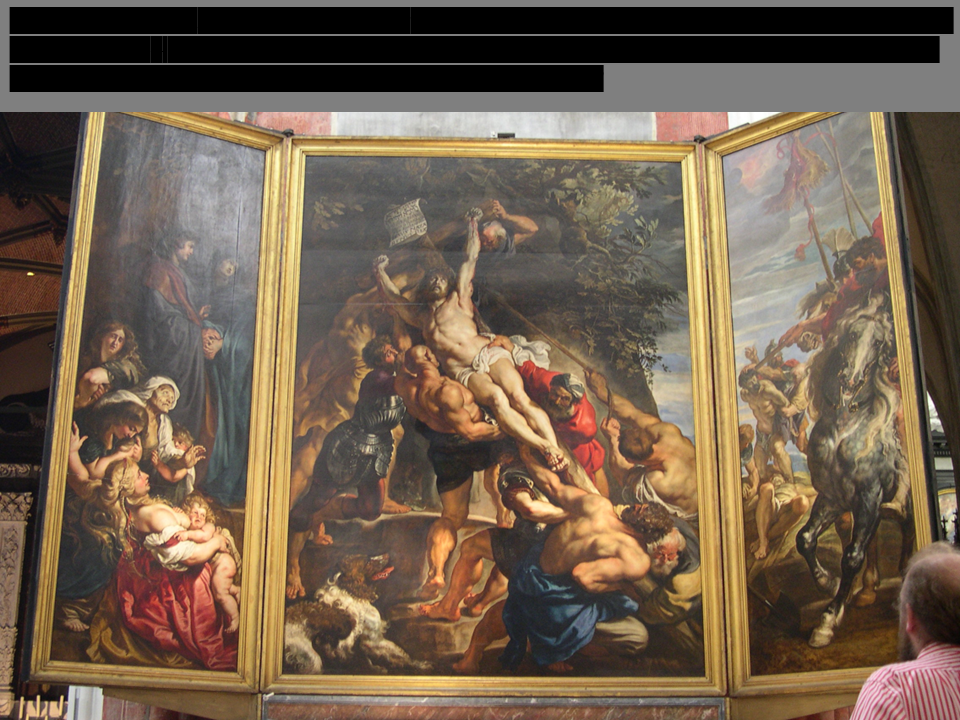
Peter Paul Rubens, *Elevation of the Cross*, Antwerp Church w/ a God the Father image above this triptych,
1610 FLEMISH BAROQUE
* What is the subject of this picture?
* How does the artist’s time studying the style of Italian artists shape his own Flemish Baroque theatricality?
* What is the subject of this picture?
* How does the artist’s time studying the style of Italian artists shape his own Flemish Baroque theatricality?
78
New cards
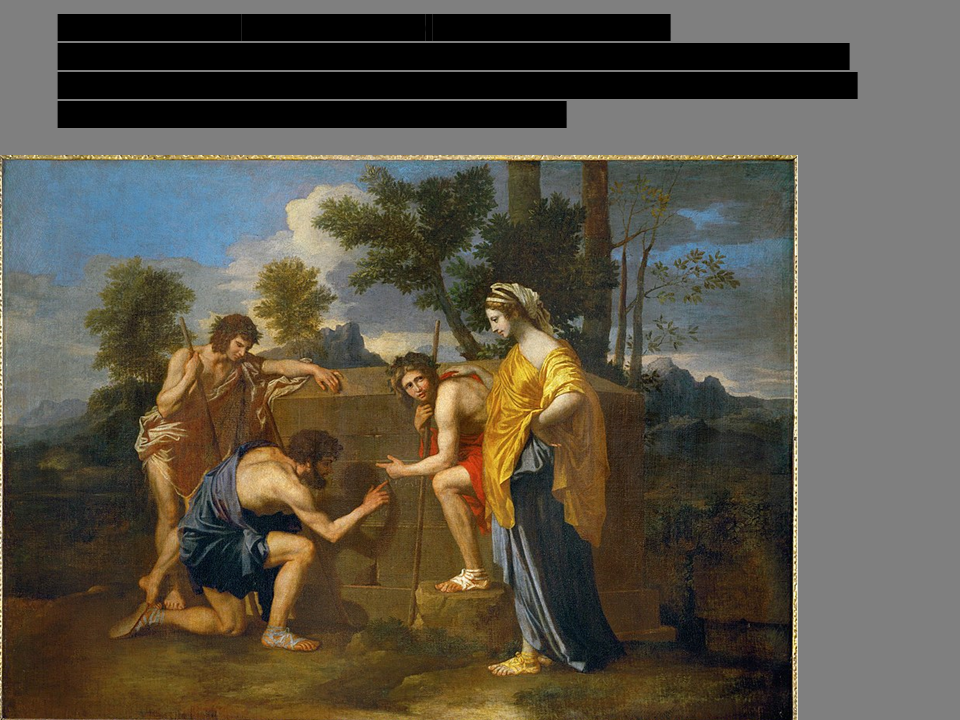
Nicolas Poussin, *Et in Arcadia Ego*
ca. 1655 oil on canvas BAROQUE
* discuss how this painting embodies the artist’s views of the “grand manner” of art that would prove influential to the French Royal Academy in subsequent centuries
* discuss how this painting embodies the artist’s views of the “grand manner” of art that would prove influential to the French Royal Academy in subsequent centuries
79
New cards
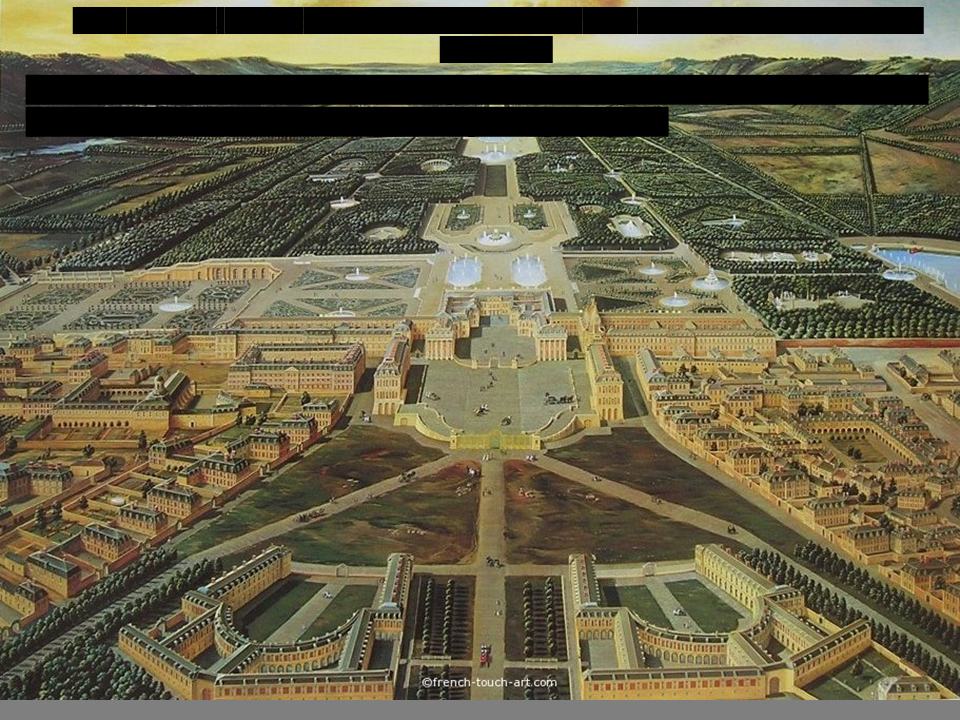
Jules Hardouin-Mansart, Charles Le Brun, André Le Nôtre, Palace at Versailles, France,
begun 1669
* Identify this settlement, and the French King behind it, and give examples of its baroque grand style, lavish interiors, and political power/propaganda
* Mansart roof
* Moves his bedroom to the Palace of Versailles
* subordinates who lived in their own palaces had to be awake when he woke
* his bedroom was surrounded by rooms with other planet names
* Identify this settlement, and the French King behind it, and give examples of its baroque grand style, lavish interiors, and political power/propaganda
* Mansart roof
* Moves his bedroom to the Palace of Versailles
* subordinates who lived in their own palaces had to be awake when he woke
* his bedroom was surrounded by rooms with other planet names
80
New cards
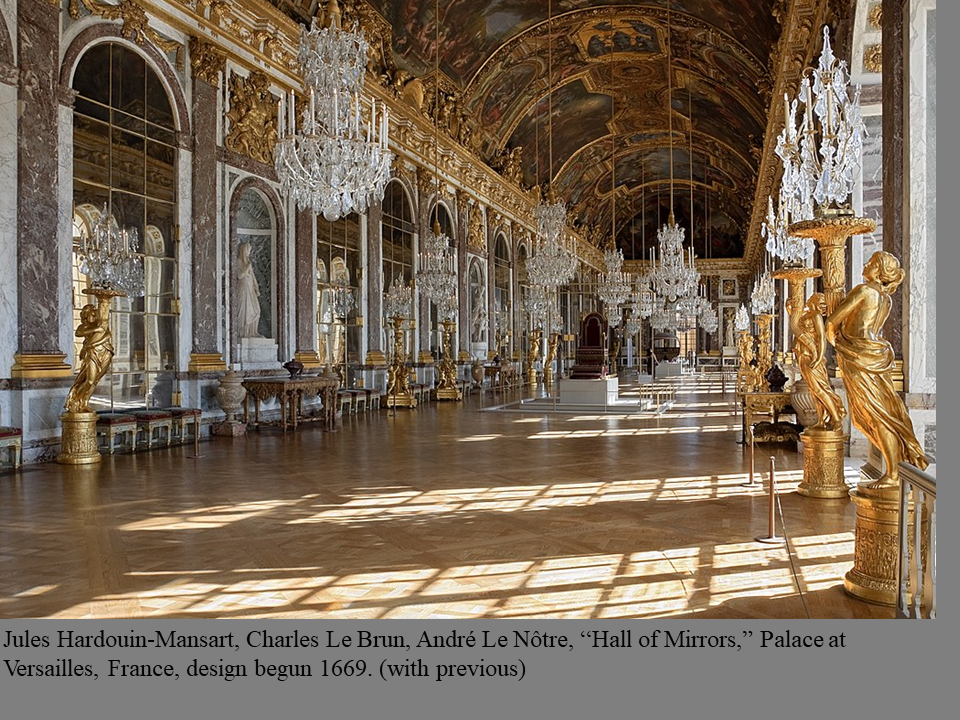
Jules Hardouin-Mansart, Charles Le Brun, André Le Nôtre, “Hall of Mirrors,” Palace at Versailles, France,
design begun 1669. (with previous)
\
\
81
New cards
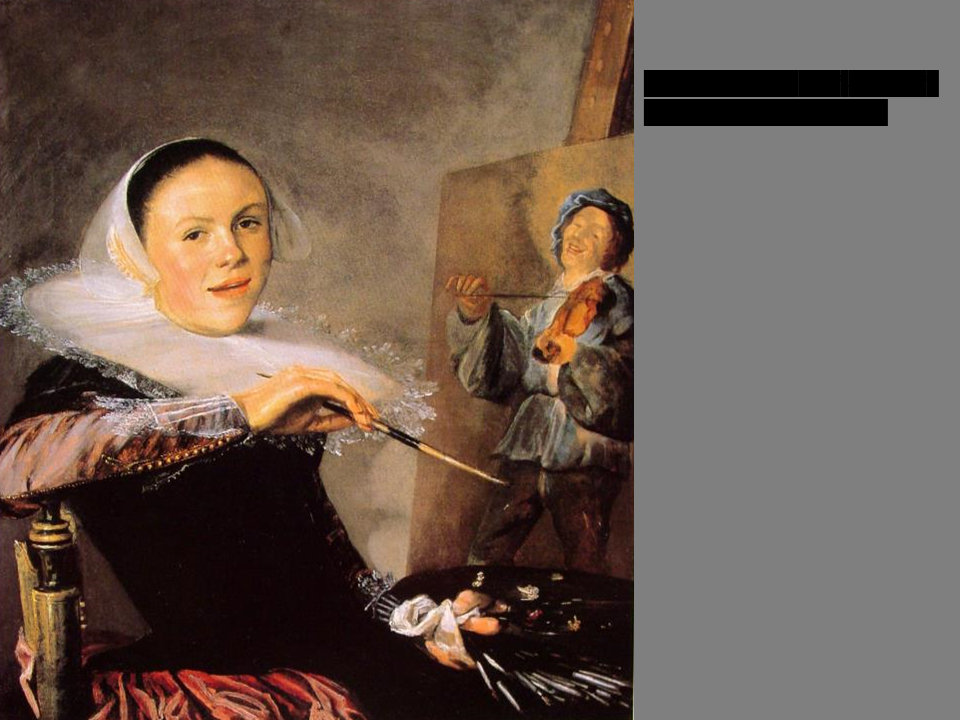
Judith Leister, *Self-Portrait*
ca. 1630, oil on canvas BAROQUE
* Her family financially supported her growth in the art but later went bankrupt
* Joined the Harlem Guild of Saint Luke’s in the 1630s\\
* Had a workshop with male apprentices
* Potential debut image into the guild
* Her family financially supported her growth in the art but later went bankrupt
* Joined the Harlem Guild of Saint Luke’s in the 1630s\\
* Had a workshop with male apprentices
* Potential debut image into the guild
82
New cards
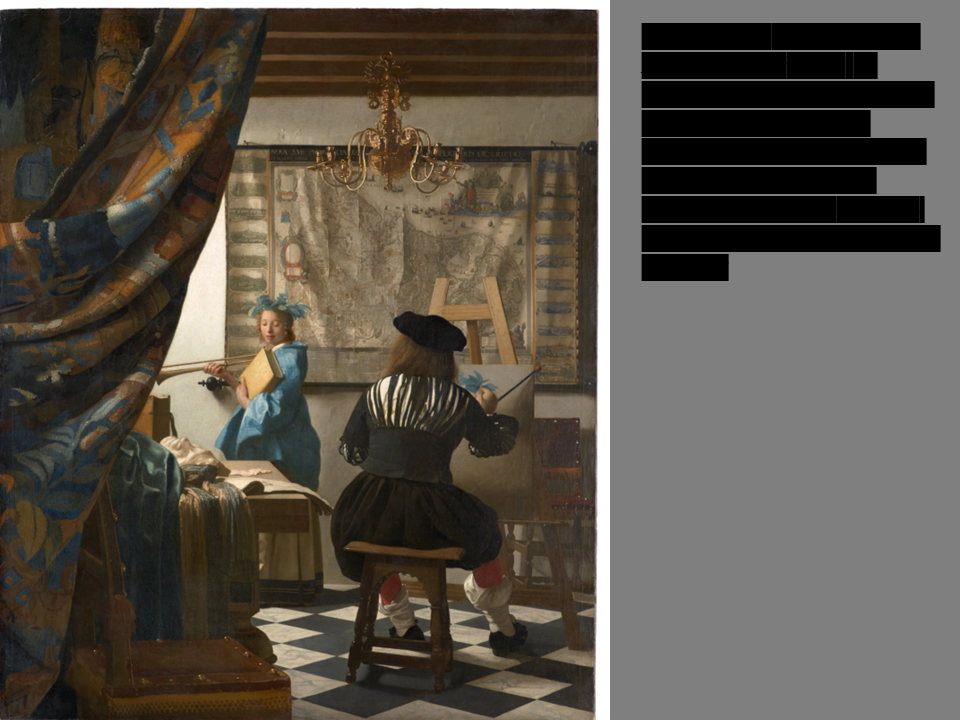
Jan Vermeer, *Allegory of the Art of Painting*,
1670-75 BAROQUE
* By what techniques and latest technology is this artist fashioning his fainting?
* How does it reflect his Dutch world?
* How does it compare to other paintings representing painting?
* Seeing artist from the back
* By what techniques and latest technology is this artist fashioning his fainting?
* How does it reflect his Dutch world?
* How does it compare to other paintings representing painting?
* Seeing artist from the back
83
New cards
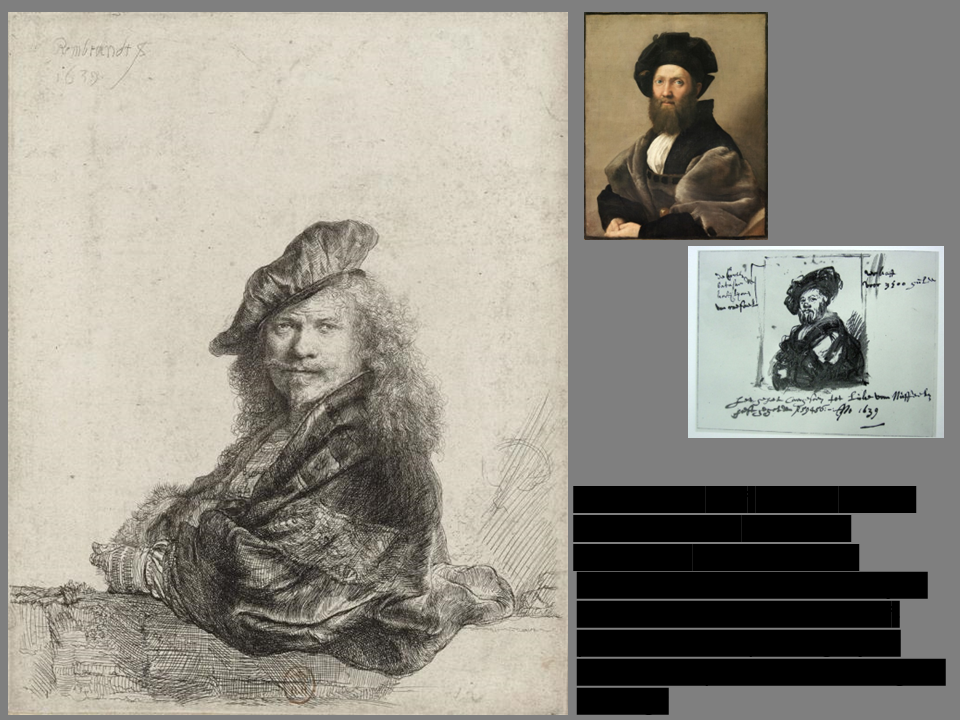
Rembrandt, *Self-Portrait* (styled after Raphael’s *Portrait of Castiglione*),
1639, etching BAROQUE
* Who was Rembrandt and why is he famous in the realm of self-portraiture?
* His painting style?
* used wet-into-wet techniques, thick impastos, and warm earth tones
* Became impoverished by the time of his late work
* Who was Rembrandt and why is he famous in the realm of self-portraiture?
* His painting style?
* used wet-into-wet techniques, thick impastos, and warm earth tones
* Became impoverished by the time of his late work
84
New cards
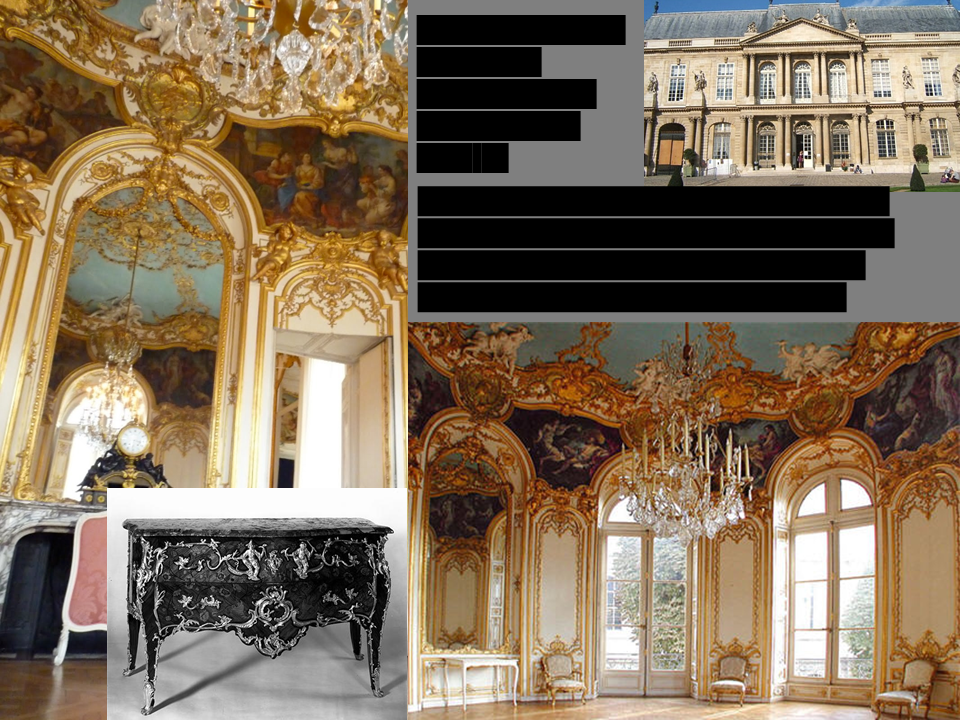
Germain Boffrand, Salon de la Princesse, Hotel Soubise, Paris,
1737-40 ROCOCO
* Identify this interior, describe what types of gatherings happened here), and elaborate on elements of Rococo interior and furniture design for someone who does not know.
* Identify this interior, describe what types of gatherings happened here), and elaborate on elements of Rococo interior and furniture design for someone who does not know.
85
New cards
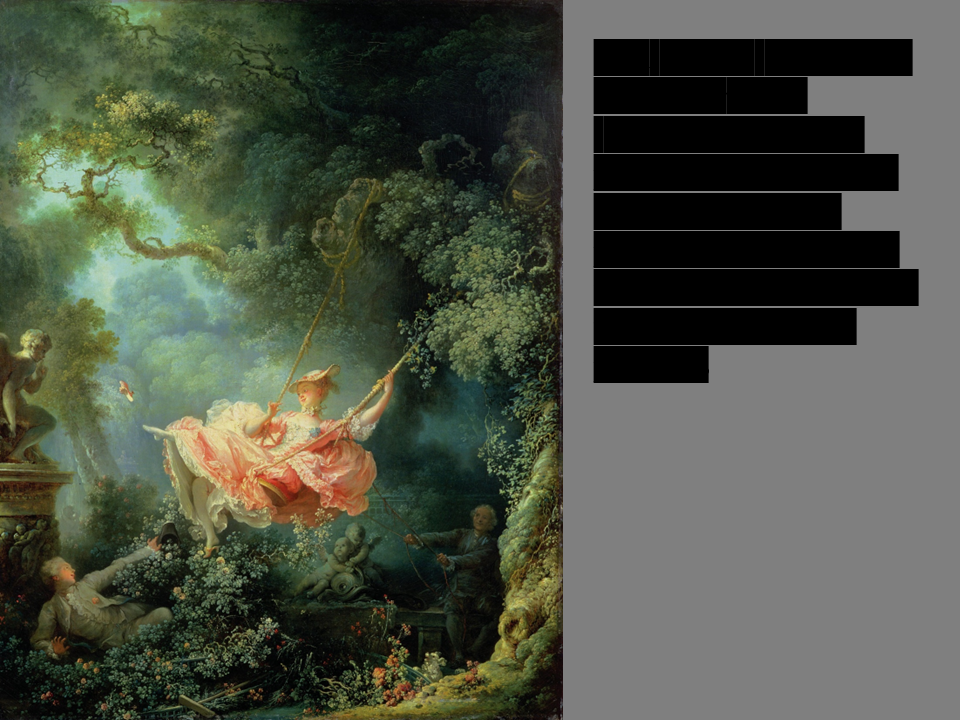
Jean-Honoré Fragonard, *The Swing*,
1766 ROCOCO
* Discuss this Rococo painting’s commission, service to the male patron’s “gaze”, and its reflection of elite French values and aesthetic priorities
* The art scene moves back to Paris instead of Versailles
* peeping tom guy, getting pushed by another
* SYMBOLISM
* Discuss this Rococo painting’s commission, service to the male patron’s “gaze”, and its reflection of elite French values and aesthetic priorities
* The art scene moves back to Paris instead of Versailles
* peeping tom guy, getting pushed by another
* SYMBOLISM
86
New cards
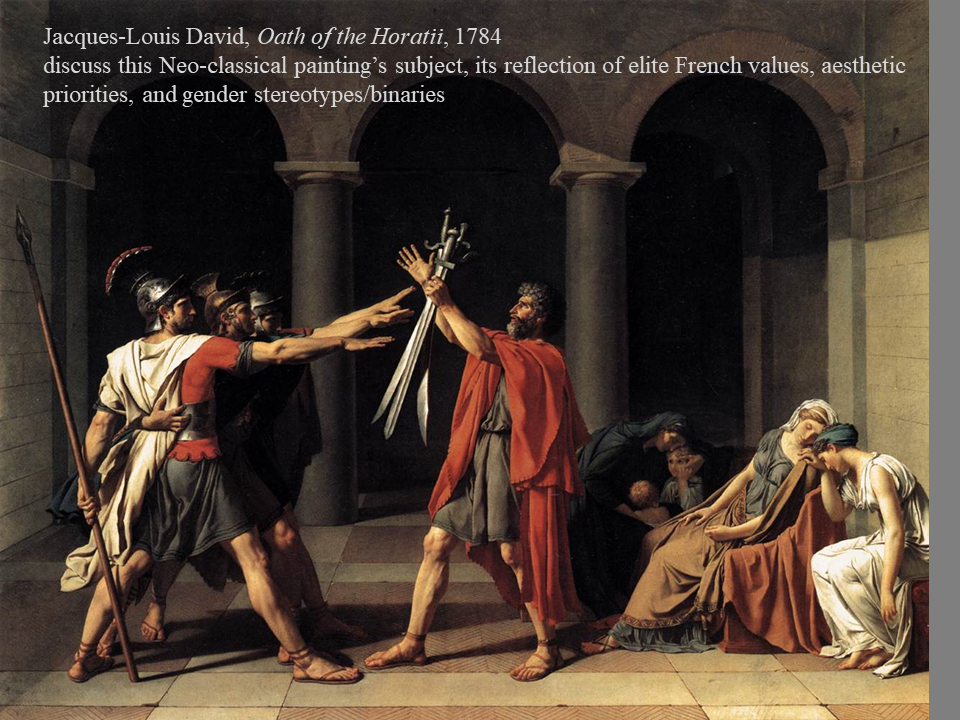
Jacques-Louis David, *Oath of the Horatii*,
1784 NEOCLASSICAL
* discuss this Neo-classical painting’s subject, its reflection of elite French values, aesthetic priorities, and gender stereotypes/binaries
* discuss this Neo-classical painting’s subject, its reflection of elite French values, aesthetic priorities, and gender stereotypes/binaries
87
New cards
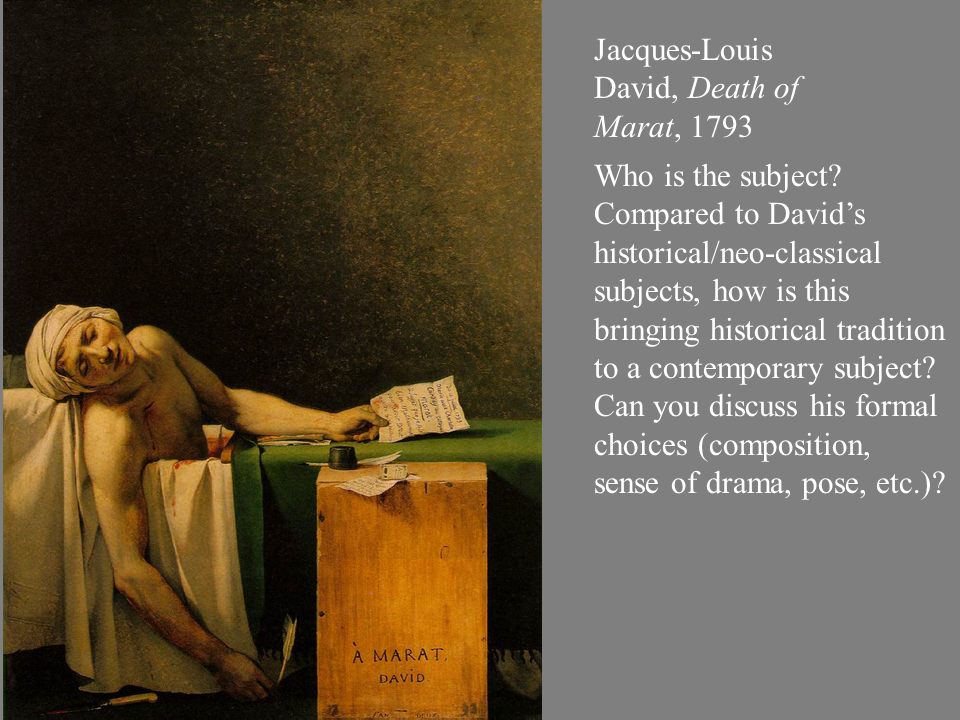
Jacques-Louis David, *Death of Marat*,
1793 NEOCLASSICAL
* Who is the subject? Compared to David’s historical/neo-classical subjects, how is this bringing historical tradition to a contemporary subject? Can you discuss his formal choices (composition, sense of drama, pose, etc.)?
* Artist signed it to Murat
* Murat was an editor of a news sheet
* murdered by supporter of the aristocracy who was a woman
* shocked paris—he basically became a crime scene artist
* Who is the subject? Compared to David’s historical/neo-classical subjects, how is this bringing historical tradition to a contemporary subject? Can you discuss his formal choices (composition, sense of drama, pose, etc.)?
* Artist signed it to Murat
* Murat was an editor of a news sheet
* murdered by supporter of the aristocracy who was a woman
* shocked paris—he basically became a crime scene artist
88
New cards
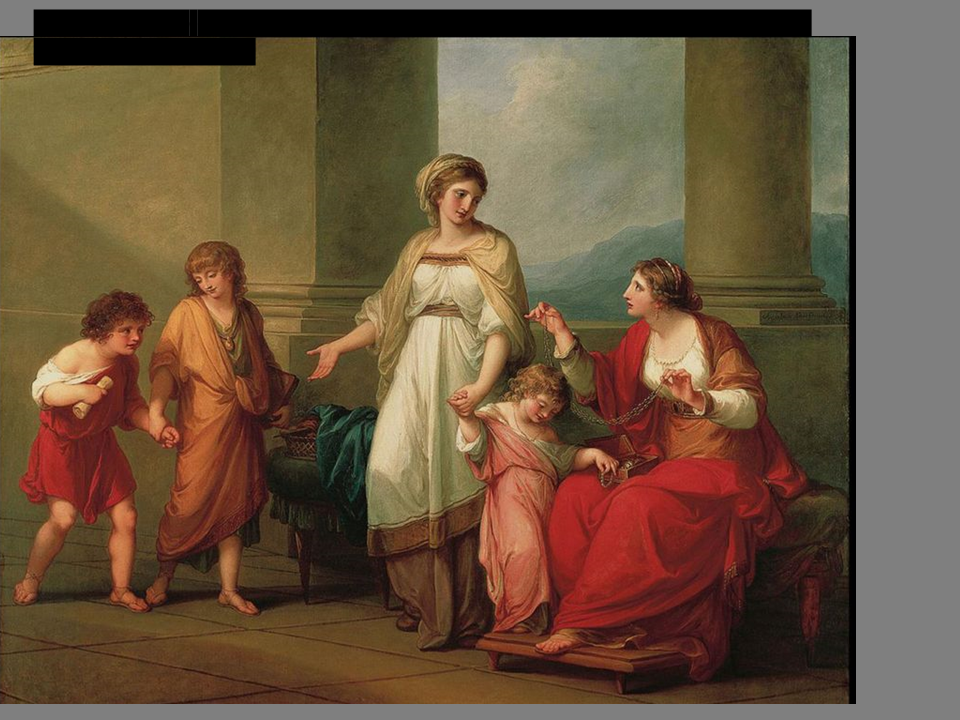
Angelica Kauffmann, Cornelia Presenting Her Children as Her Treasures,
ca. 1785 NEOCLASSICAL
Moral is about one’s honor and one’s family being place before material goods
Moral is about one’s honor and one’s family being place before material goods